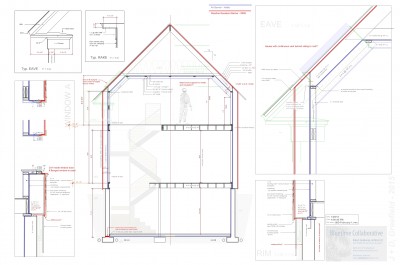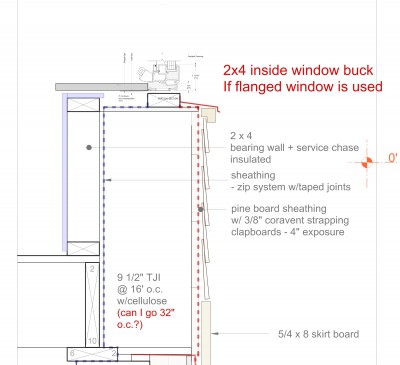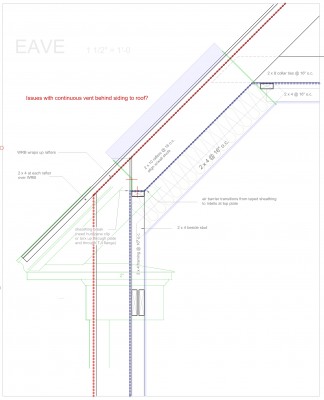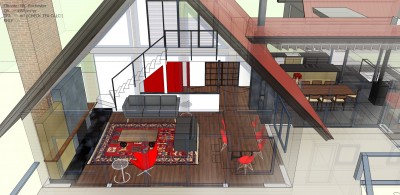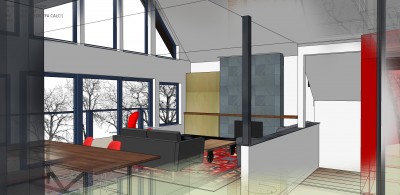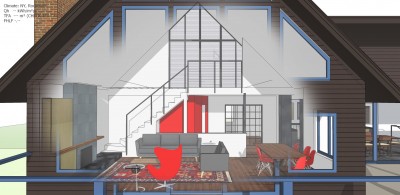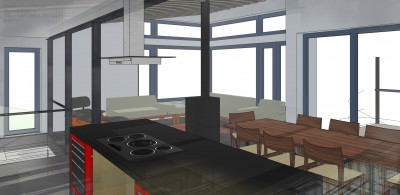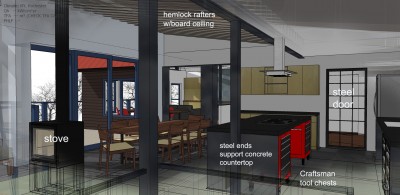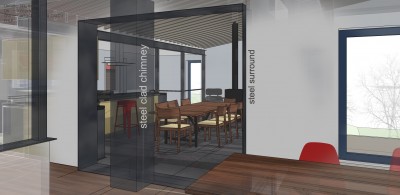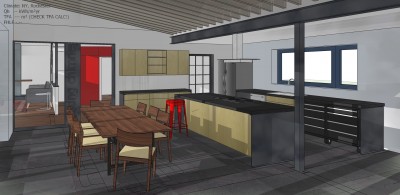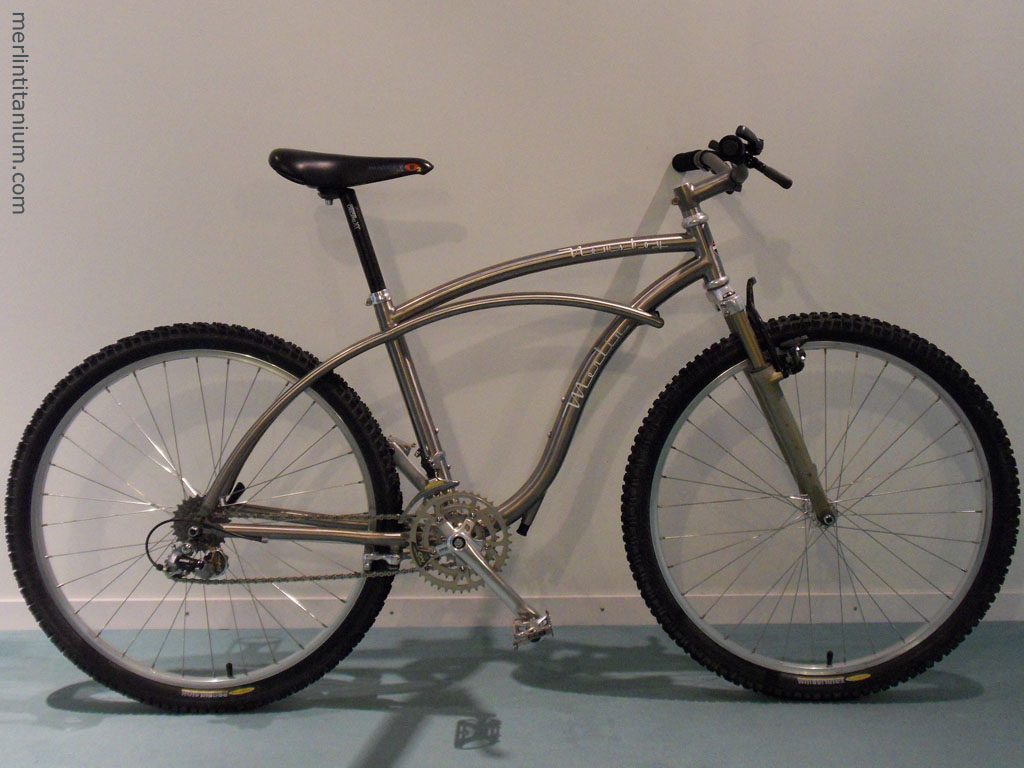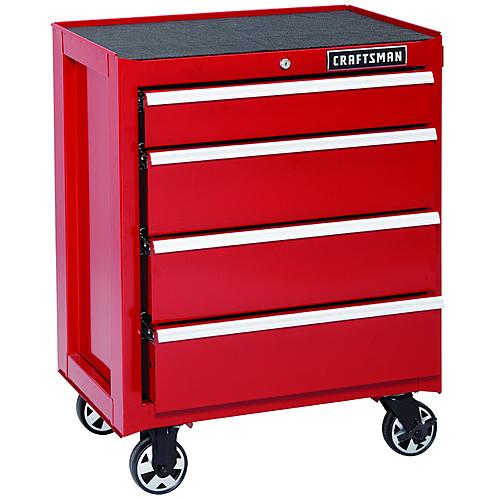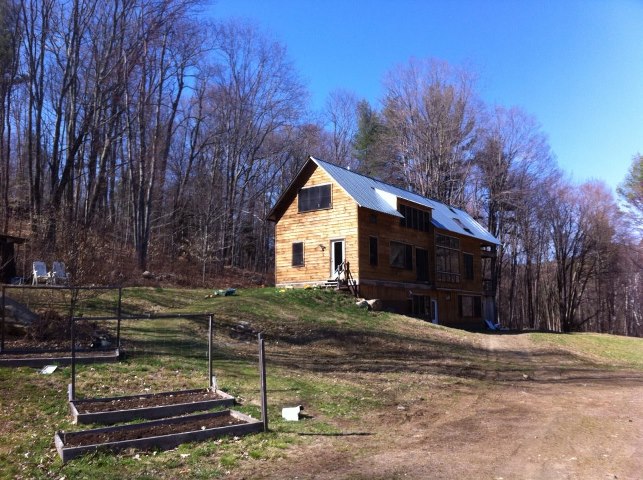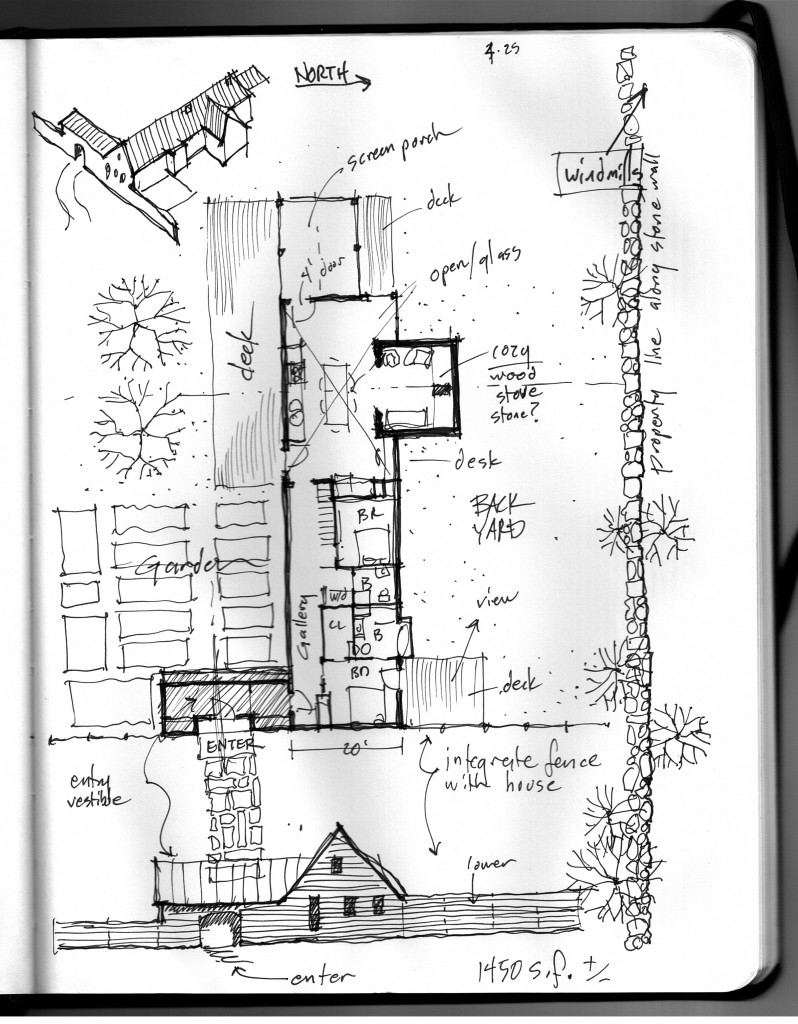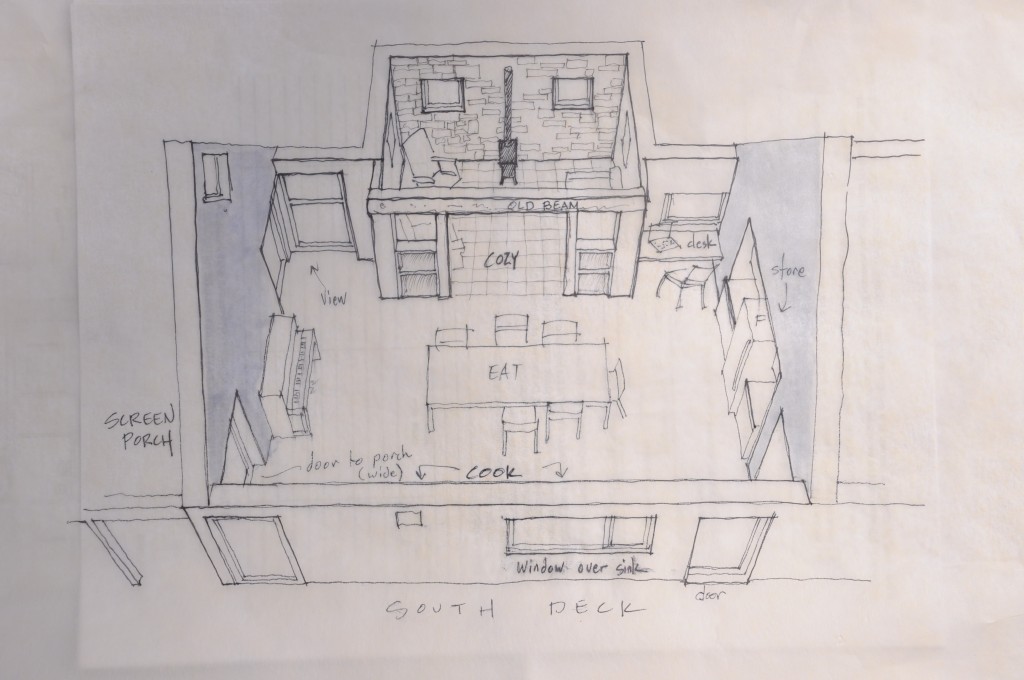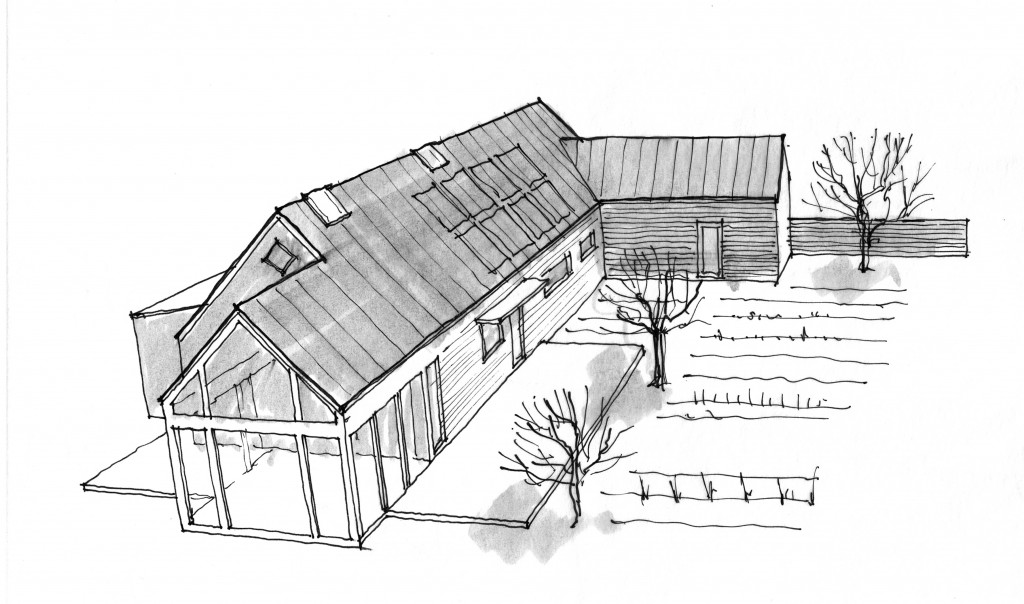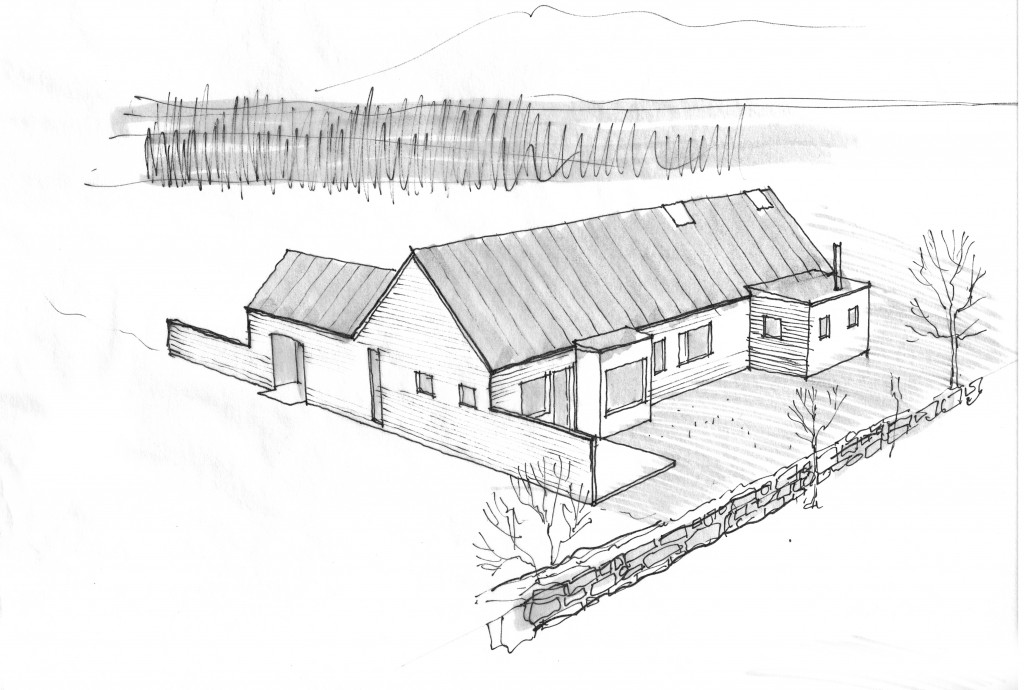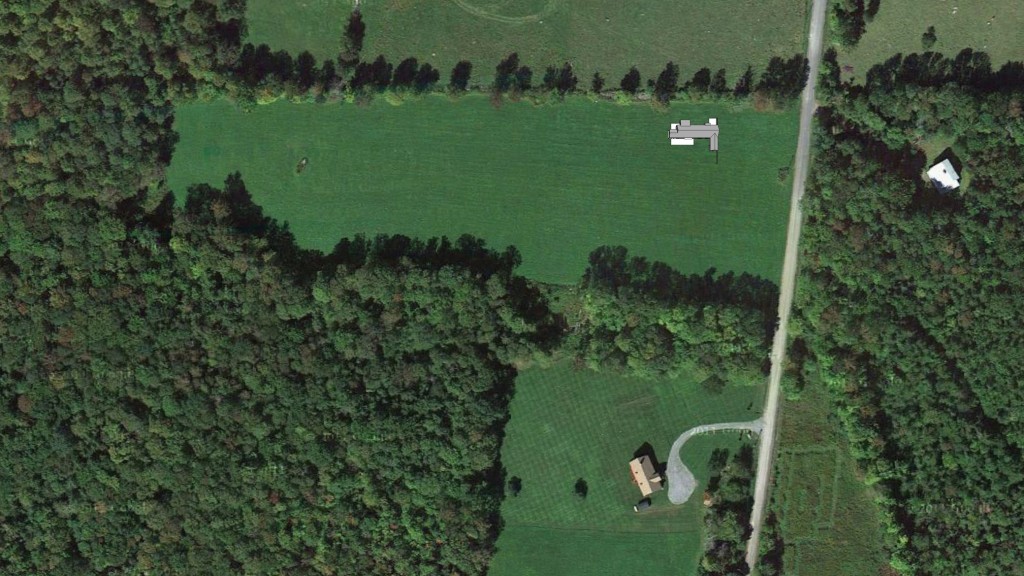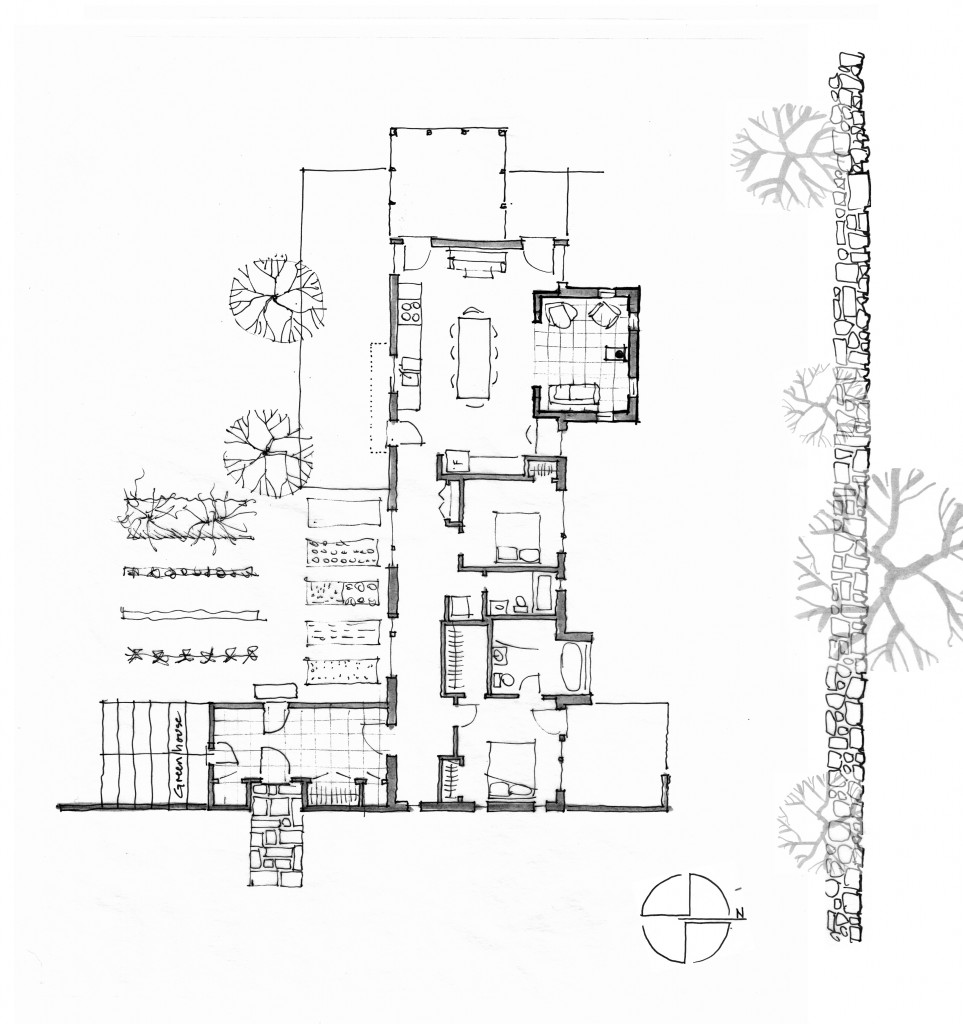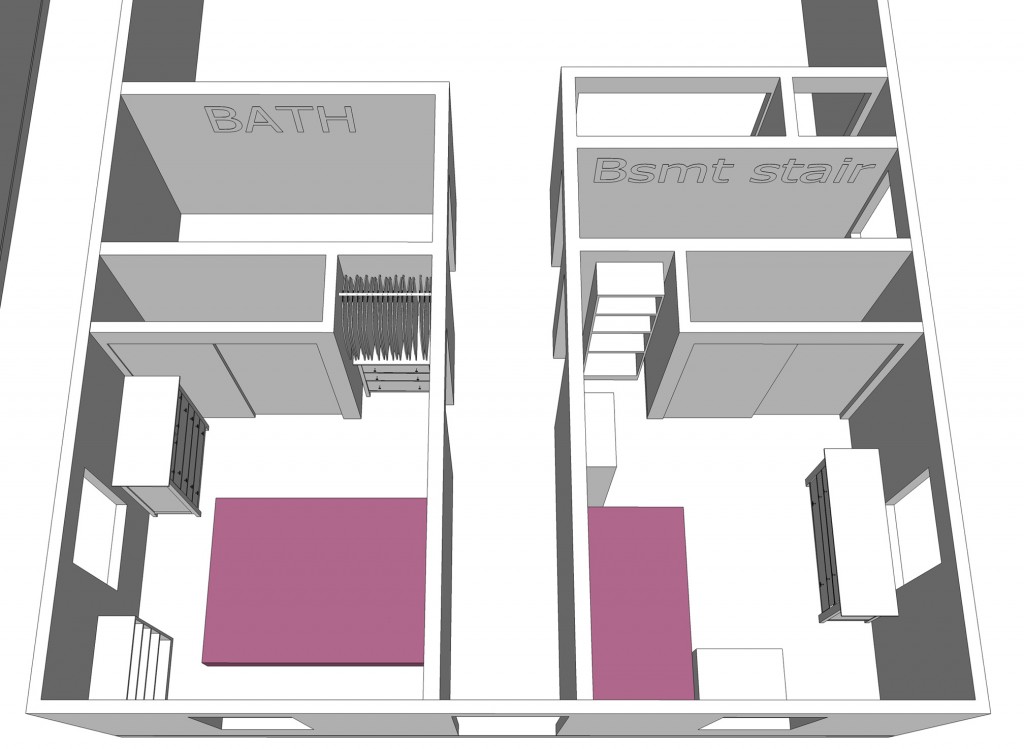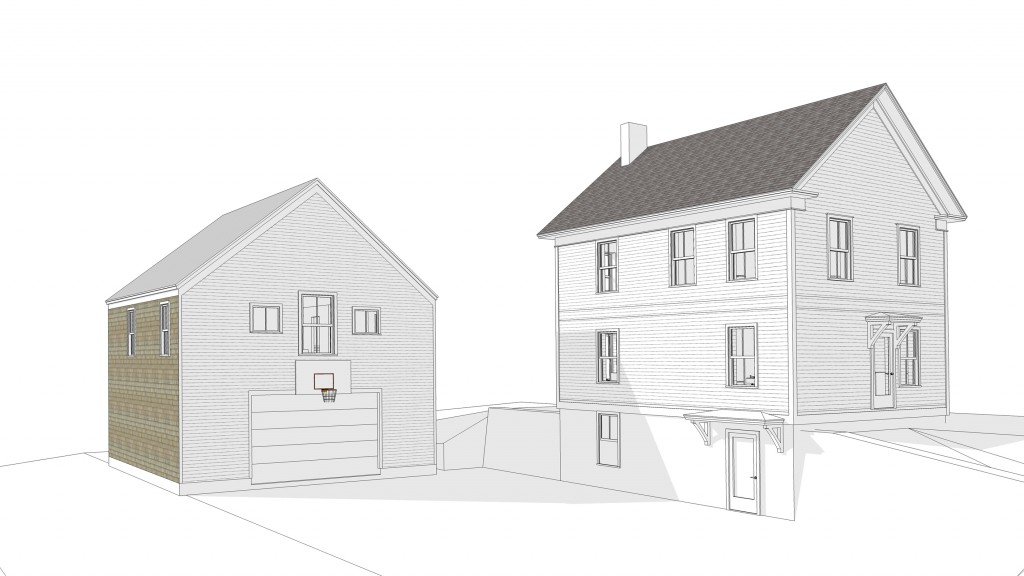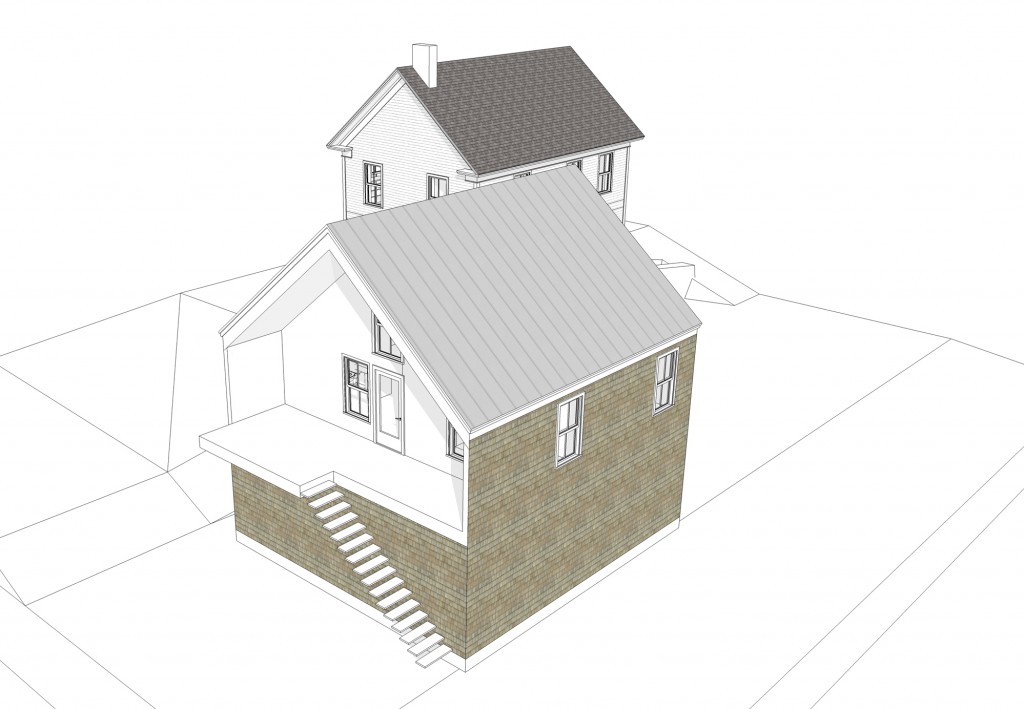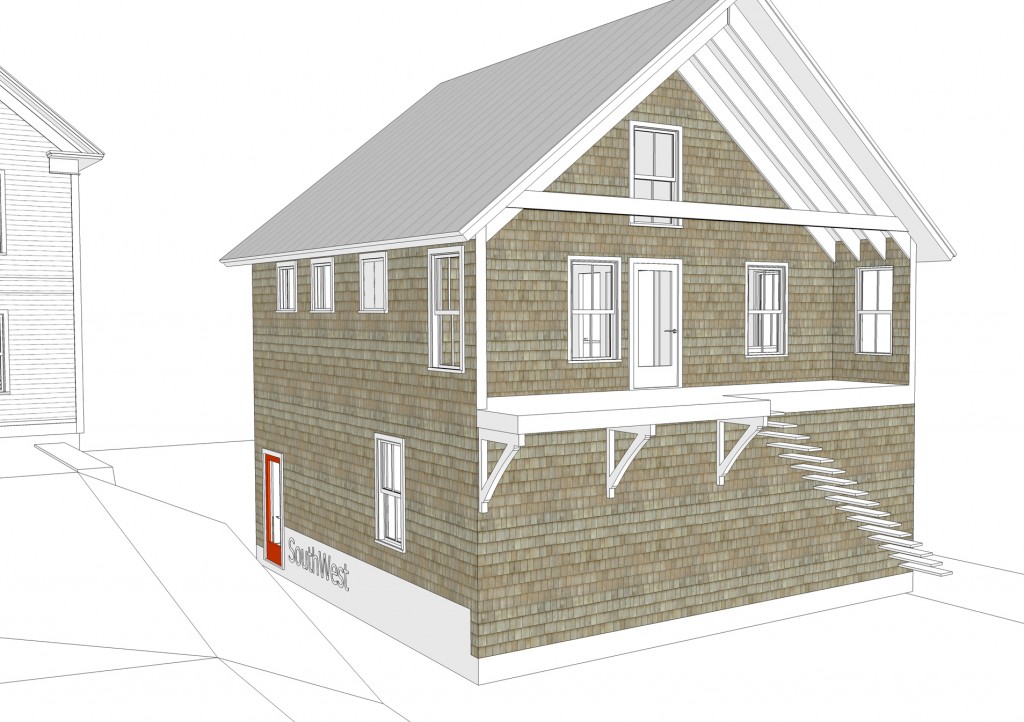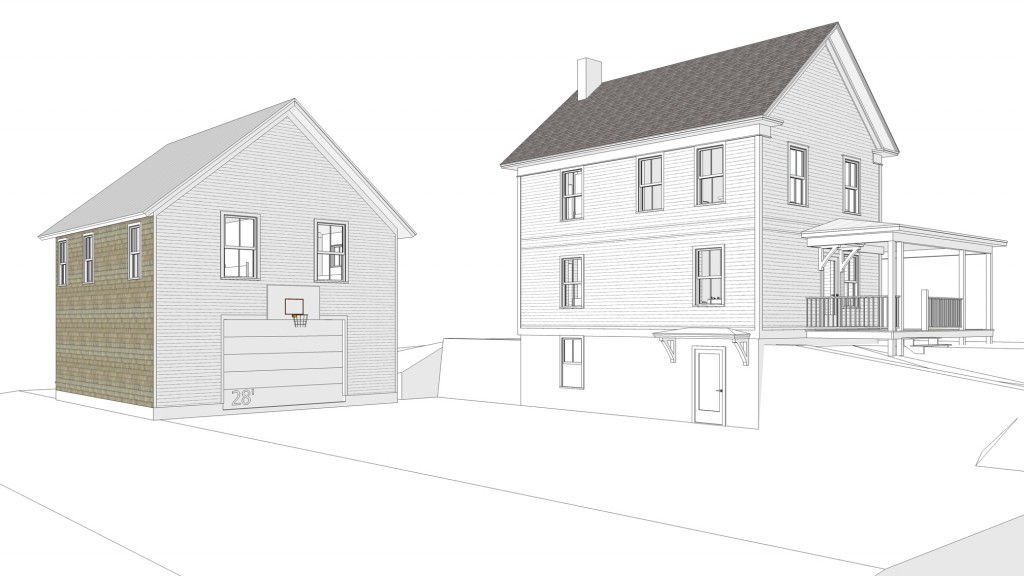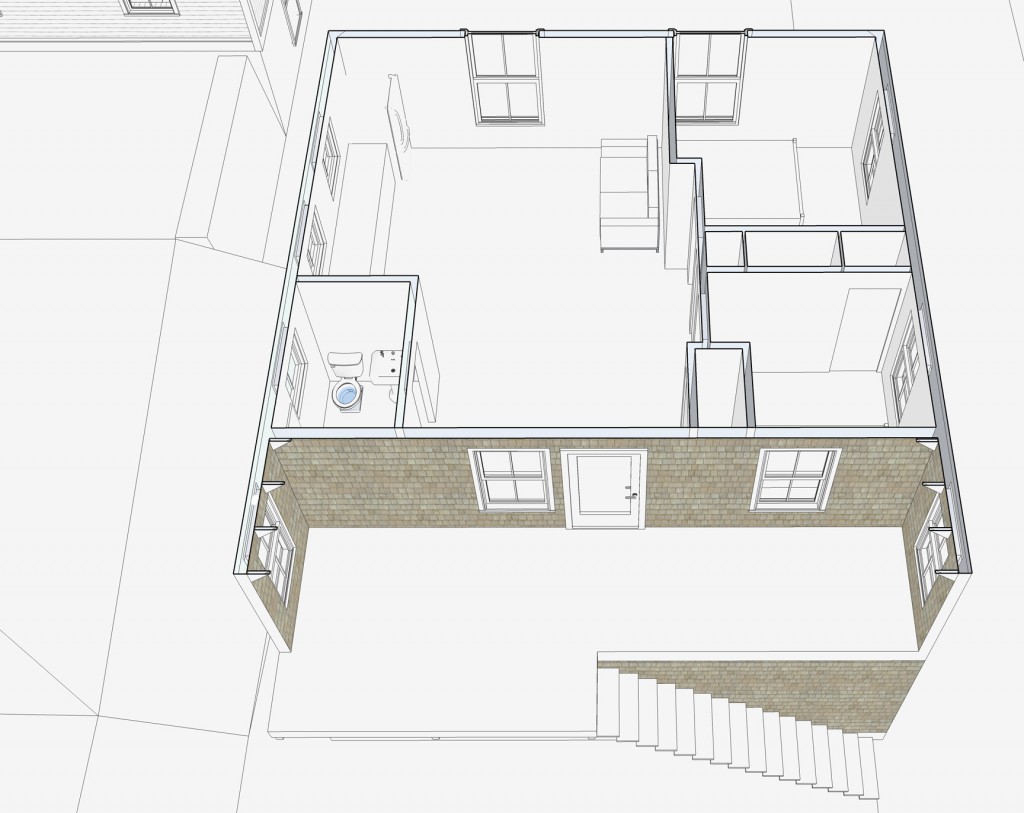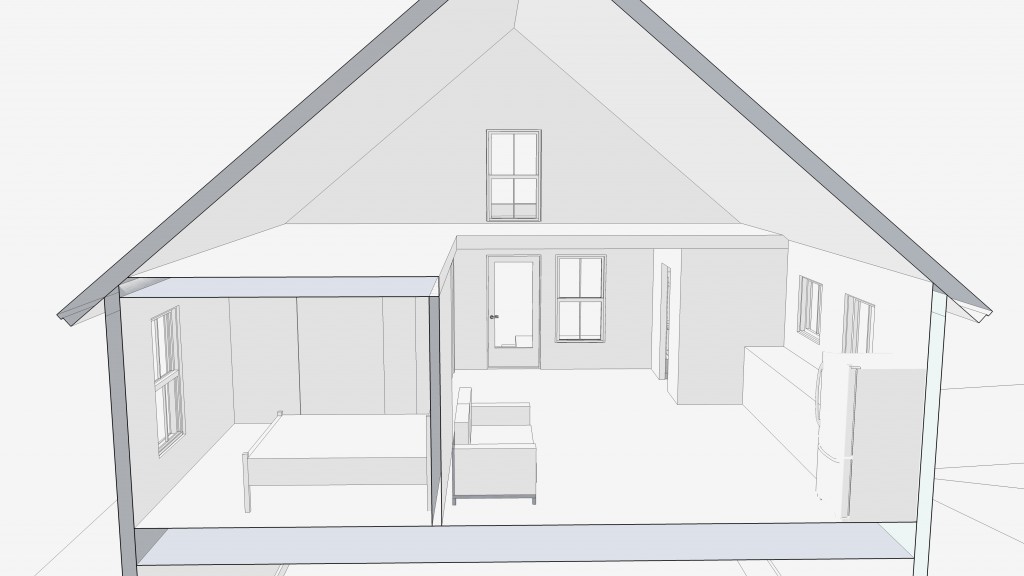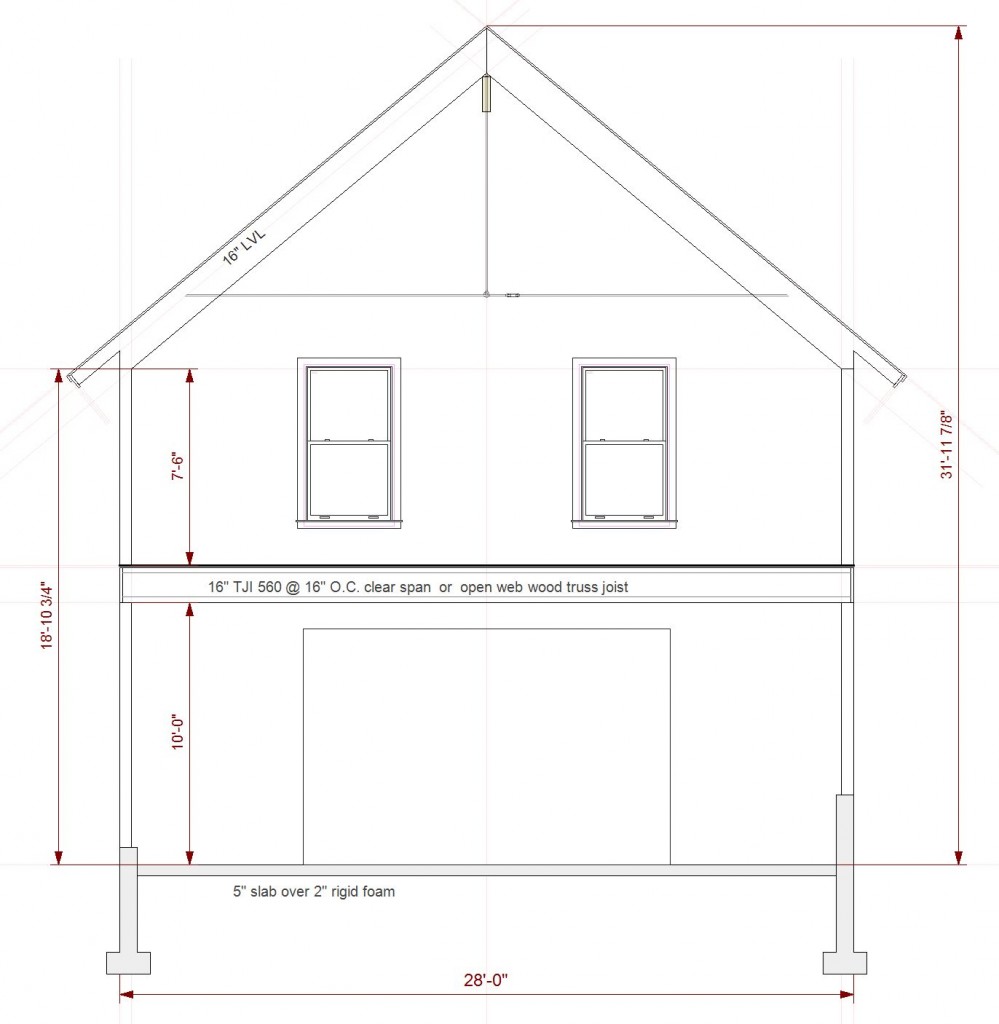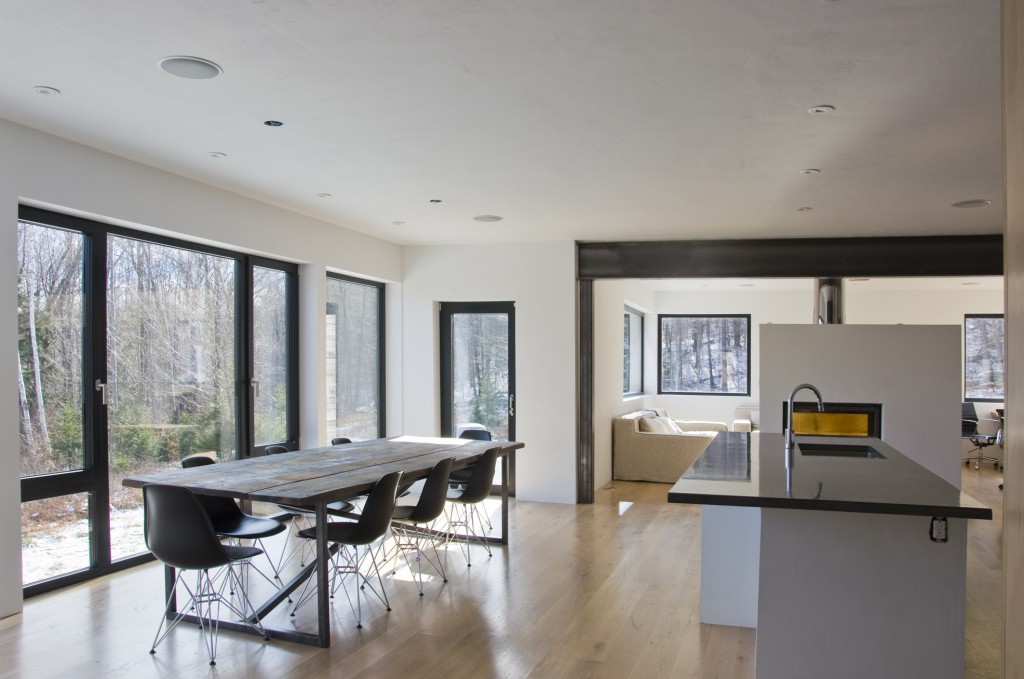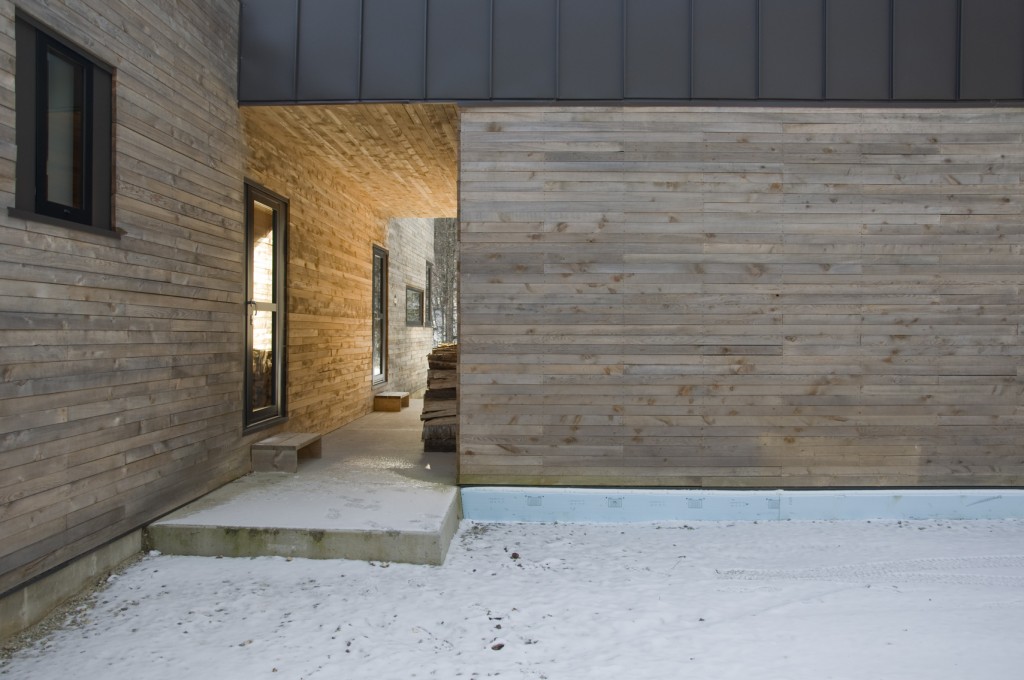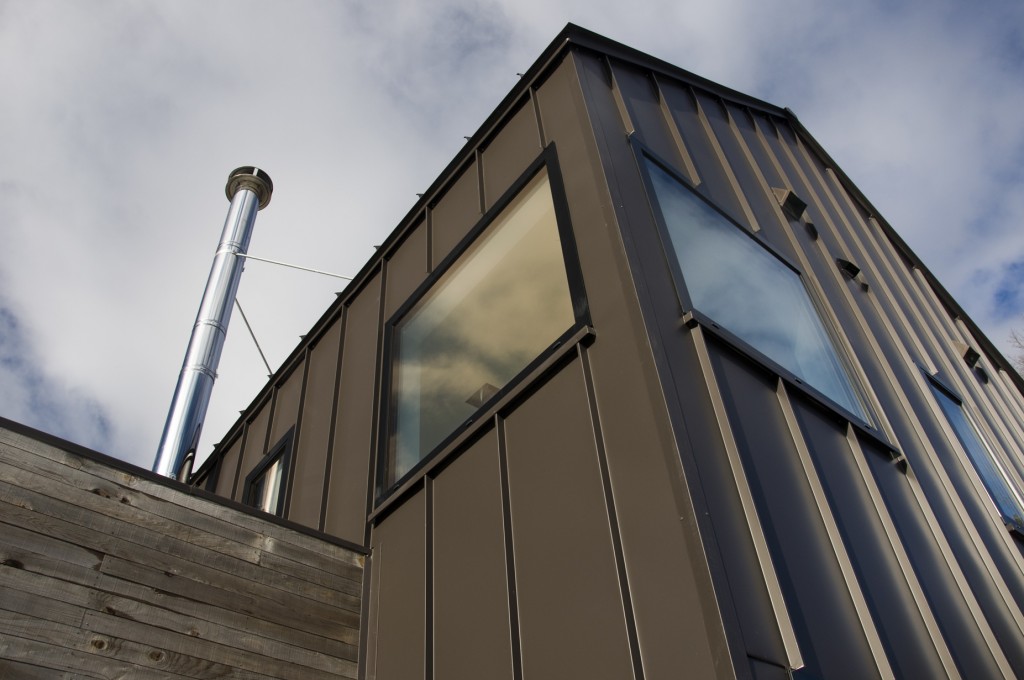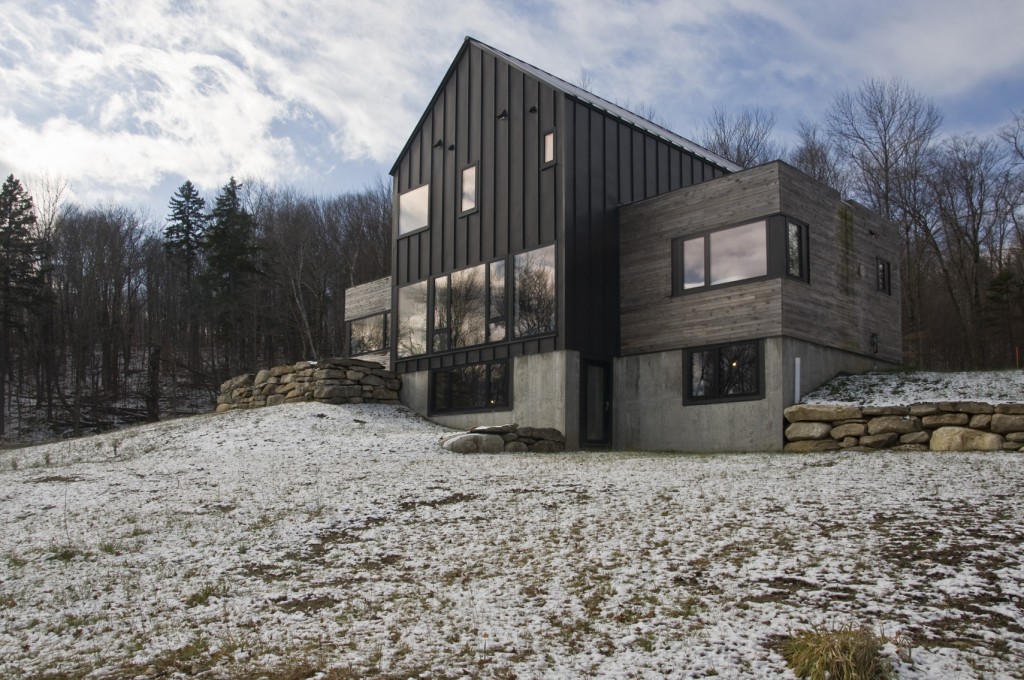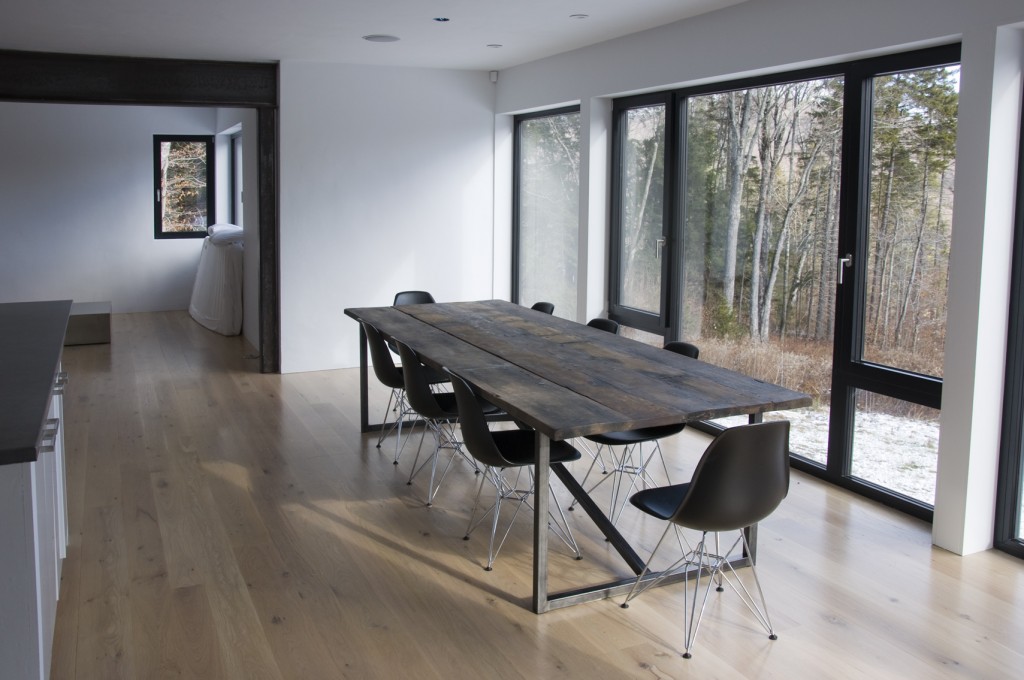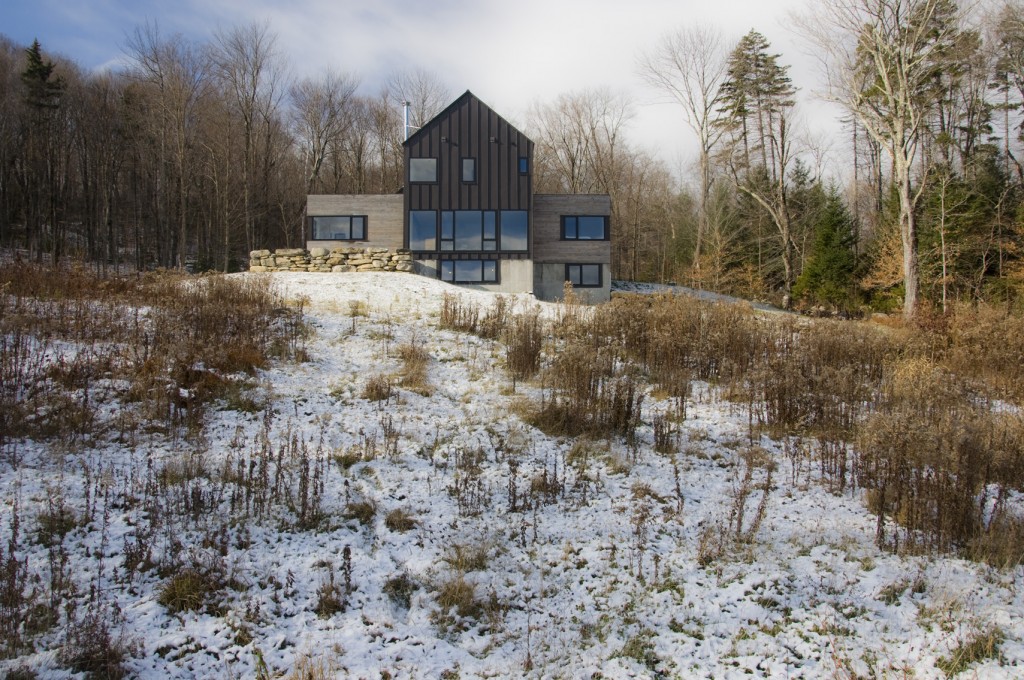I am fascinated with the Tiny House Movement. Tiny House on Wheels is THOW btw. I would like to have one as guest quarters (or an airstream) but after living in a smallish (900 s.f.) house for 15 years I know that a tiny house is not for me. I do have plans to add several hundred square feet in the form of a functioning kitchen, eating area, mudroom, and a work area so I can ditch the in-town office. A THOW would have been perfect when I was young and single. I actually lived in an 8x12 cabin in the woods for 6 months sometime in the 90’s. Other than the mice and raiding raccoons, it wasn’t bad. I moved out when I started getting cold in late fall. -Pictured above Kids take up a lot of room and in our climate, you can’t just kick them outdoors to ride their bikes or do huge art or building projects. Plus each kid has to have two snowsuits, multiple winter boots, sleds, tons of books, a guinea pig (my daughter wants a cow and chickens) Not very applicable to tiny house living. Check out my friend Sean’s tiny house related blog UnBoxed House. He is building his own house using a shipping container. Although I have done a few tiny houses for clients I find I have to keep the tiny house mentality out of my regular work and attitudes, at least for now. I have found that some people are Big House People and a few (very few) are small house people. The usual conundrum comes when people have tiny house budgets but are horrified when I suggest that they need to be looking at something smaller than 1500 s.f. given their budget and their desire for quality. I once had a client who was horrified and outraged that I had designed a house with 10x12 bedrooms for her boys. (her budget was 350k) (plus she wanted a garage) Where I grew up that was a big enough bedroom for 2 boys to share. I will push and nudge and suggest like crazy but some people are just “Big House People” I have a hard time relating sometimes but I try. I nod my head sympathetically when a clients who are expecting their first child and live in a house twice the size of my own have called me in to discuss an addition to accommodate their growing family. Fine if they can afford it. I know from experience that I feel strangely uncomfortable in a house bigger than 2000 s.f. It feels wrong. Likewise a big bedroom. I contribute that to my introvert nature more than anything. I must be a medium house person. I follow a few tiny house groups on Facebook but try to ignore them mostly as people put up photos of their tiny houses that they built that, as an experienced architect, I can see that in five years, the house will be a falling apart mold factory. My face hurts too much from that sort of thing. But I applaud the do-it-yourself nature of the movement and the growing wealth of information and support.
Portit mollis vitae
Nullam ornare, sem in malesuada sagittis, quam sapien ornare massa, id pulvinar quam augue vel orci. Praesent leo orci, cursus ac malesuada et, sollicitudin eu erat. Pellentesque ornare mi vitae sem consequat ac bibendum neque adipiscing. Donec tellus nunc, tincidunt sed faucibus a, mattis eget purus. Nunc ipsum orci, consectetur in euismod id, adipiscing nec libero. Vivamus sed nisi quam. Donec id arcu non libero pellentesque condimentum at in mauris. Duis et lacus lectus, eu aliquet tortor. Maecenas cursus consectetur tellus non lobortis. Donec sed arcu a justo cursus varius ut et diam. Suspendisse lobortis pulvinar velit, id convallis eros pulvinar ac. Cras a lorem lorem, et feugiat leo. Nunc vestibulum venenatis est nec tempor. Nunc mattis sem in mauris posuere aliquam.
Always know what and where your AIR BARRIER is.
I’m working on detailing out a smallish house in Greenfield, MA. We probably won’t go full Passive House on this but we will look at what additional costs and detailing it would take. And if we’re close…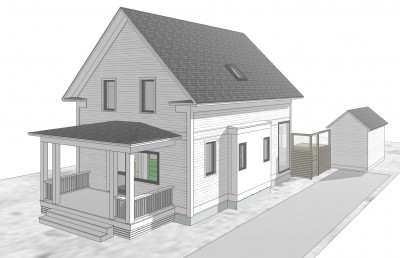 We are doing some novel (to me) stuff for the shell of the house that, I suspect, will become more standard practice for me in years to come.
Here are some “progress print” detail drawings from the plan set. My drawings tend to look a bit different than most architect's drawings due to two things: The time I spent wielding a hammer and trying to interpret my own drawings and the fact that I have worked as a sole practitioner for so long and have developed my own graphic style. I should add to that a third thing – my knowledge of building science informed best practices.
We are doing some novel (to me) stuff for the shell of the house that, I suspect, will become more standard practice for me in years to come.
Here are some “progress print” detail drawings from the plan set. My drawings tend to look a bit different than most architect's drawings due to two things: The time I spent wielding a hammer and trying to interpret my own drawings and the fact that I have worked as a sole practitioner for so long and have developed my own graphic style. I should add to that a third thing – my knowledge of building science informed best practices.
The first thing you will notice about these drawings is actually the most important thing. The red and blue dotted lines represent the weather resistant barrier and the air barrier respectively. If your drawings don’t have at least the air barrier called out in the sections, (and continuous around the thermal envelope) The drawings are incomplete. I have been getting picky in my detailing about how to make the air barrier both easy to achieve and durable. In my opinion, relying on painted sheetrock to serve as an air barrier just doesn’t cut it – certainly not for the next 100 years.
Many builders and architects in the Northeast US are still building 2x6 walls with fiberglass batts and a poly vapor barrier. That’s how I learned to do it when I was just starting out in the 90’s. I also opened up a number of walls built that way that were full of mold.
-
Good
builders don’t build this way anymore. Check the Building Science Corporation website for some pictures of what can go wrong.
One part of building science is probability and statistics. I often hear builders say “I’ve always built that way and I’ve never had any problems” - that you know about. But those builders are only looking at 50 or 100 projects. Luck plays a part here. What happens when you look at thousands or even tens of thousands? You start to see some patterns emerge and you start to see the luck factor drop out of the equation. You are able to formulate some best practice standards for a number of things including durability, air quality, energy use and even catastrophic failure. I prefer to work with builders who are informed about building science and involved in the discussion.
That’s easy here in the Southeastern Vermont area home of Building Green area, home of Building Green and SEON which sponsors a well-attended monthly building science discussion group and learning circle. – If anyone wants to get something like this started in their own community, send Guy an email at the address in their website.
I owe it to my clients to help them get the best constructed project possible. That, in addition to the most functional, aesthetically appropriate, finely crafted project possible.
– Oh and the budget thing too –
Detailing such as represented in these drawings is also very much about budget. The goal is to bump up the levels of insulation, air tightness, r value of windows etc. so that we can eliminate the traditional boiler and heat distribution system in favor of a minisplit heat pump which is more of an appliance than a system and dramatically less expensive. (I think this link is a GBA pro only link - subscription) For those without a subscription try this alternative Ideally, it becomes a wash cost wise but with the added bonus of very low monthly heating and cooling costs. Those savings alone can represent hundreds of dollars per month.
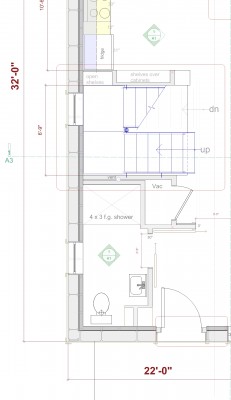
Mod Ski Home in VT - interiors
I'm working on fleshing out the interiors for this addition renovation project here in Vermont.
G-Jan-4 from Robert Swinburne on Vimeo.
Old Fashioned Stoves in New England
I grew up in Maine with a large wood cookstove similar to this one. Cooking in it was sketchy and it was far from tight or efficient. The top surface and oven provided excellent places to keep pies and already cooked food warm on Thanksgiving. My own home has a small efficient and relatively airtight woodstove tucked into the stone fireplace. It has a knurled top surface which makes it hard to even heat water on but it does a good job of heating the house and the front is a large widow so we can watch the wood burn. (nice) We used to have an old fashioned parlor stove but it was too big and inefficient (and a bit scary when it ran hot) It now sits in the barn awaiting installation out there for use during barn parties. Here is what it looked like in place:
Cooking in it was sketchy and it was far from tight or efficient. The top surface and oven provided excellent places to keep pies and already cooked food warm on Thanksgiving. My own home has a small efficient and relatively airtight woodstove tucked into the stone fireplace. It has a knurled top surface which makes it hard to even heat water on but it does a good job of heating the house and the front is a large widow so we can watch the wood burn. (nice) We used to have an old fashioned parlor stove but it was too big and inefficient (and a bit scary when it ran hot) It now sits in the barn awaiting installation out there for use during barn parties. Here is what it looked like in place:
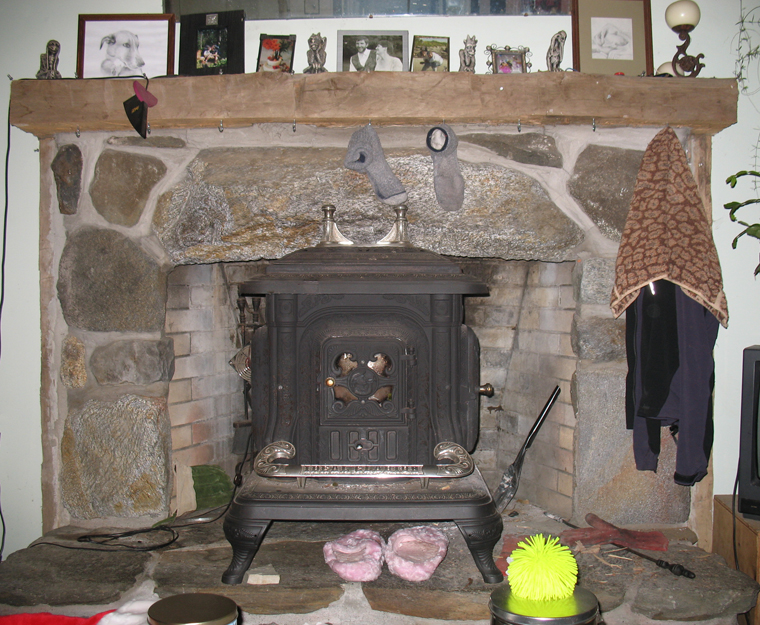 Please ignore the pink fuzzy slippers and yellow koosh ball. And the socks...
I would love to have a spot in my home for a modern wood cookstove such as this:
Please ignore the pink fuzzy slippers and yellow koosh ball. And the socks...
I would love to have a spot in my home for a modern wood cookstove such as this:

Here are some places in New England that restore and sell antique wood stoves.
Once Upon a Time Antique Stove Shop in Vermont. VPR recently did a story on them HERE
Good Time Stove Co. in Massachusetts

Bryant Stove and Music in Thorndike ME
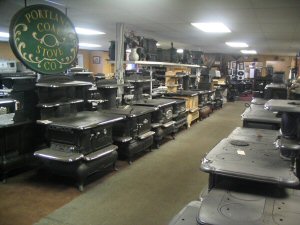 I purchased my own parlor stove from this place and it is truly amazing. there are not only hundreds of stoves but an antiques museum and a huge room packed full of dolls and gizmos that, when you flip the switch upon entering all erupt into action including merry go rounds, dancing dolls, teddies on airplanes, circus bands....I can't really describe it well. Here is a Boston.com article that does a better job and an image from their article
I purchased my own parlor stove from this place and it is truly amazing. there are not only hundreds of stoves but an antiques museum and a huge room packed full of dolls and gizmos that, when you flip the switch upon entering all erupt into action including merry go rounds, dancing dolls, teddies on airplanes, circus bands....I can't really describe it well. Here is a Boston.com article that does a better job and an image from their article
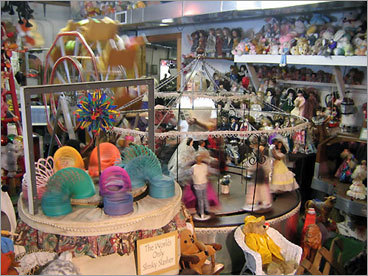 did I mention Slinkys?
did I mention Slinkys?
Education of an Architect('s wife)
The Day I Became a Modernist—Guest Post by the Architect's Wife There was a time in my life when I would not have uttered the word “modernist” without an accompanying sneer. My aesthetic tastes then ran toward the…dilapidated. If it was old with a sagging roof, I liked it. Bonus points if it looked like it might fall over any minute. I loved dark little stone cottages that probably had little light and abundant mildew inside.
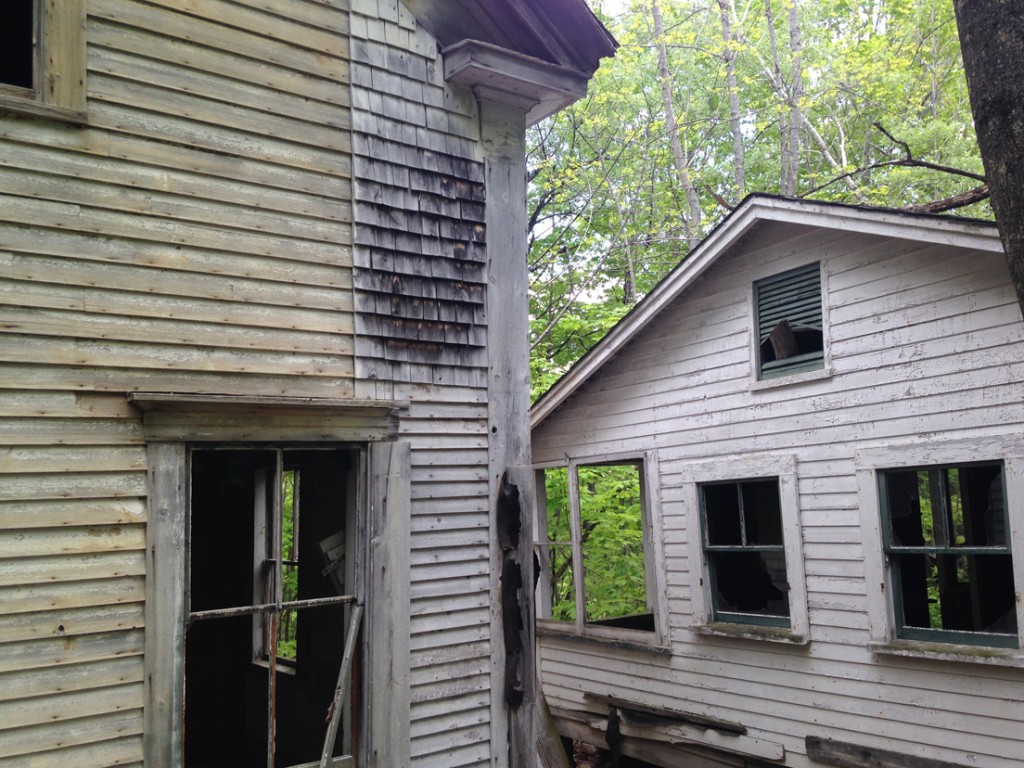 No Bob - maybe more like this:
No Bob - maybe more like this:
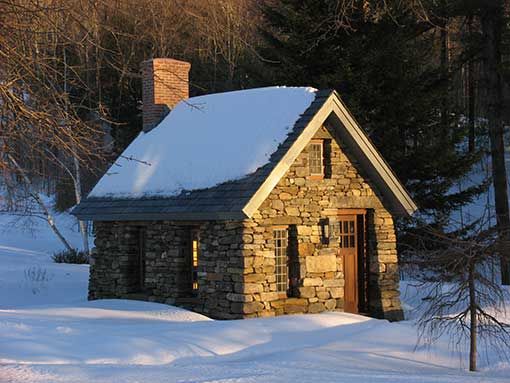 but crappier - ed.
but crappier - ed.
When I was a child visiting my grandparents in Chicago, I was bored to tears by the Frank Lloyd Wright tour.
Then I met Bob. Who will describe how he was moved to tears the first time he saw Falling Water.
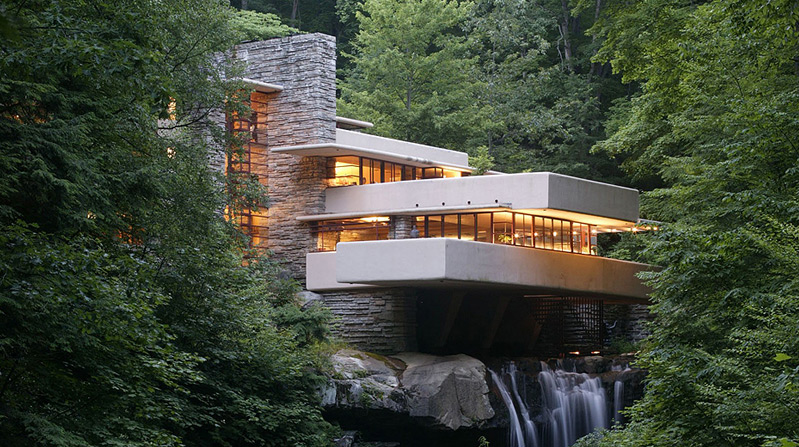
Gradually, from listening to him talk I began to be more open-minded. I realized that much of what I had derided was not actually modernist, but rather the post-modern stucco’d bland that was the hallmark of the late ‘80s gentrification during my teenage years in Seattle. Under Bob’s tutelage, I developed an appreciation for the concept of modernism as something that embraced clean simplicity, elegance in minimalism, form in the service of function. But I still didn’t really like it.
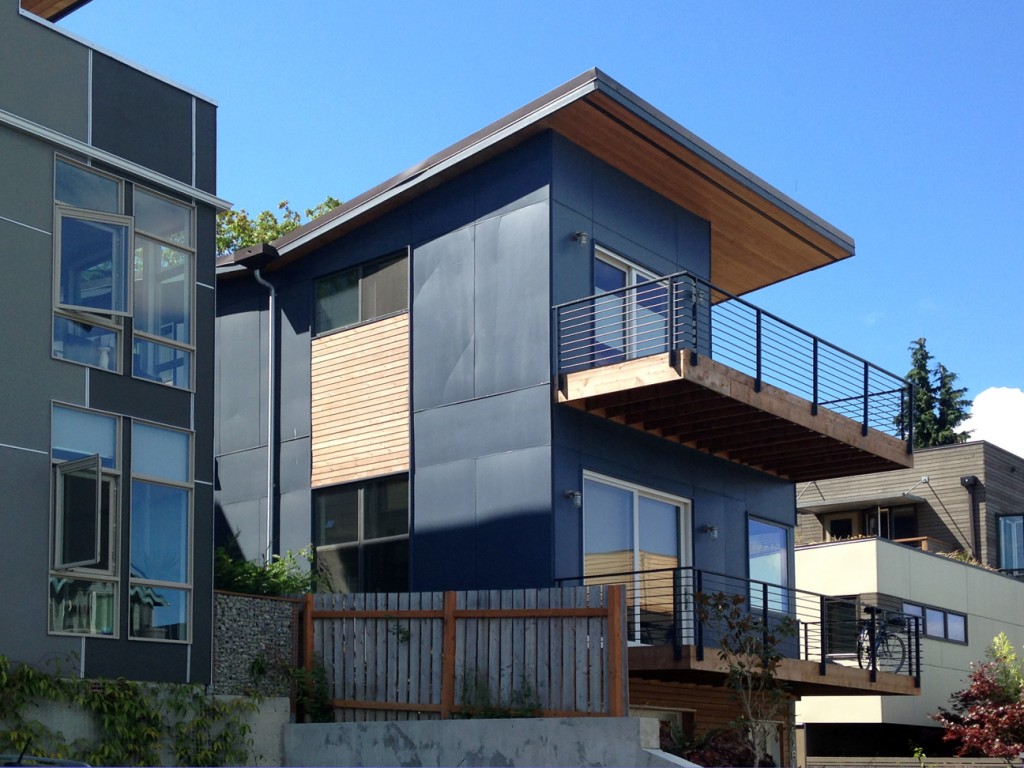
The other thing for which Bob helped me develop an appreciation was bicycling. I had not owned a bike since the one I had at age 8 that had pedal brakes and a coveted banana seat. But since he was an avid cyclist, I got a basic mountain bike and began learning some technical skills for riding the trails. I loved riding but rolled my eyes when he would wax eloquent about sleek steel or clean joints or carbon fiber. To Bob, a well-made bicycle is a work of art.
About a year and a half into our dating, Bob and I took a trip out West to Seattle (my childhood home), Portland and Northern California. Since one of Bob’s favorite pastimes was (is) visiting bike shops to ogle the merchandise, we stopped at a large shop in Portland. After forty minutes or so I was feeling glazed and wandered to a different part of the shop.
And there, at the end of an aisle, I saw it. It was titanium. It was sleek. It was retro. For the first time, I could understand the urge to hang a bicycle above the mantle. The angels were still singing when Bob found me staring slack-jawed at the Merlin Newsboy. If I recall, he nodded patiently with a knowing smile as I sputtered about how beautiful and perfect it was. That Christmas, he got me a Merlin decal as a joke (the actual bicycle was a limited edition with a price tag something on the order of $3500, and didn’t come in my size frame anyway).
By the following Christmas after that, we had gotten married and bought our home together. Browsing through the tool department at Sears, the angels sang for me a second time. Bright red, ball-bearing Craftsman cabinets. Those drawers feel downright sexy, how smoothly they open and close. Open-close, open-close I went as Bob looked at table saws or something. And all I could think was : kitchen utensils!!
So I guess that sort of clinched me as a modernist. And I even like the buildings now, too (I challenge anyone to not love weathered core-ten steel cladding).

I suppose fifteen years of living with Bob has rubbed off on me. But I still love dilapidated, too.
Progress on Mod ski home in Vermont
One of the projects I'm working on is an addition to and renovations of a ski home in Vermont. The main house is well built and and other than a maroon and pink bathroom and rather 80's finishes, we are not doing anything too major to it.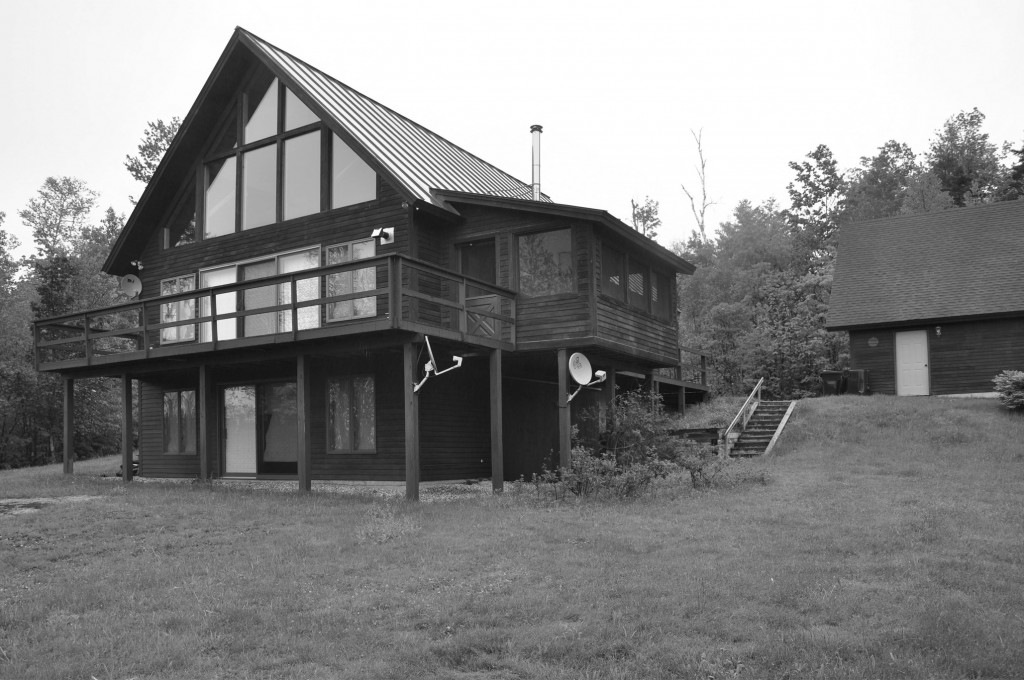 We are locating a family room addition between the existing house and garage which will provide a much nicer kitchen and living area plus additional bunkrooms and a multi-user bath on the basement level. I'm sticking with the dark clapboard and red standing seam roof of the existing as I think it provides a nice base for some fun things to happen with color at the doors and windows.
We are locating a family room addition between the existing house and garage which will provide a much nicer kitchen and living area plus additional bunkrooms and a multi-user bath on the basement level. I'm sticking with the dark clapboard and red standing seam roof of the existing as I think it provides a nice base for some fun things to happen with color at the doors and windows.
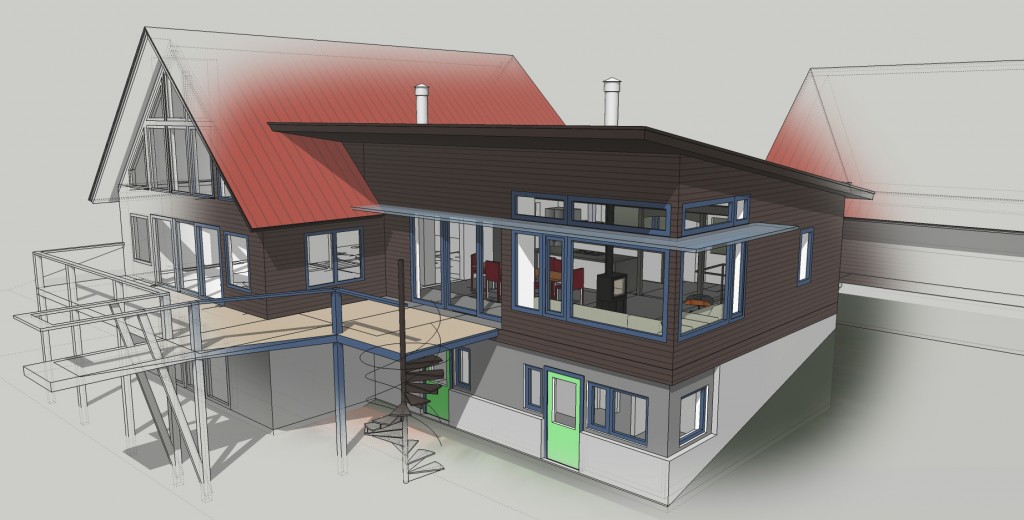
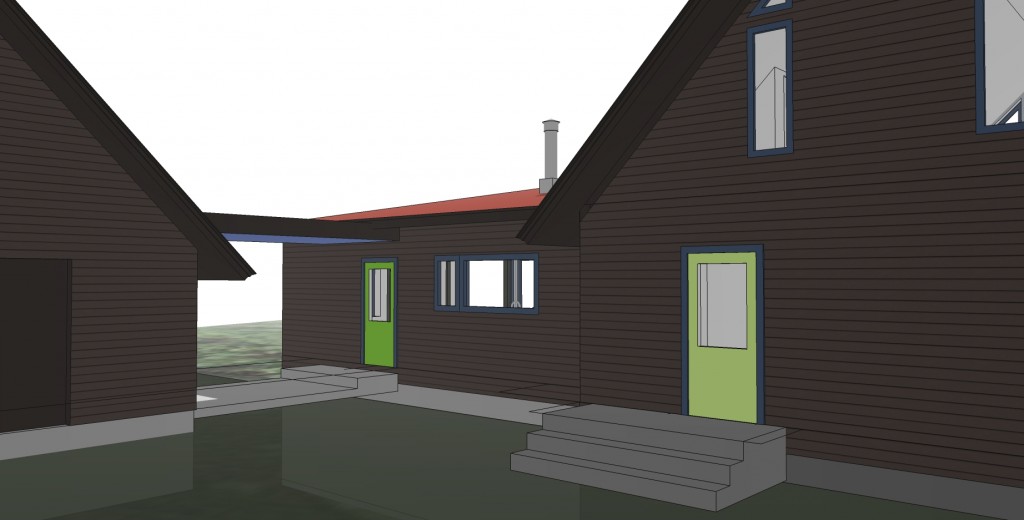
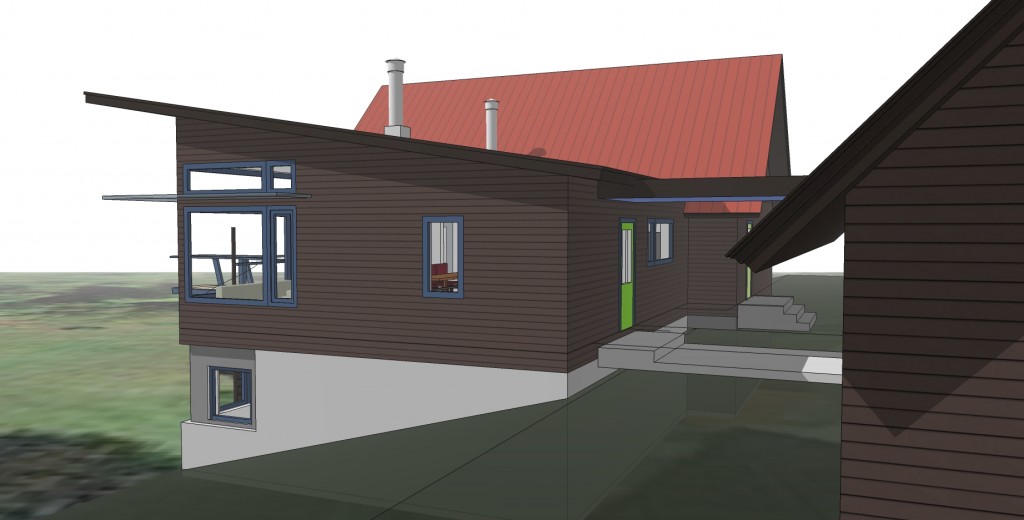
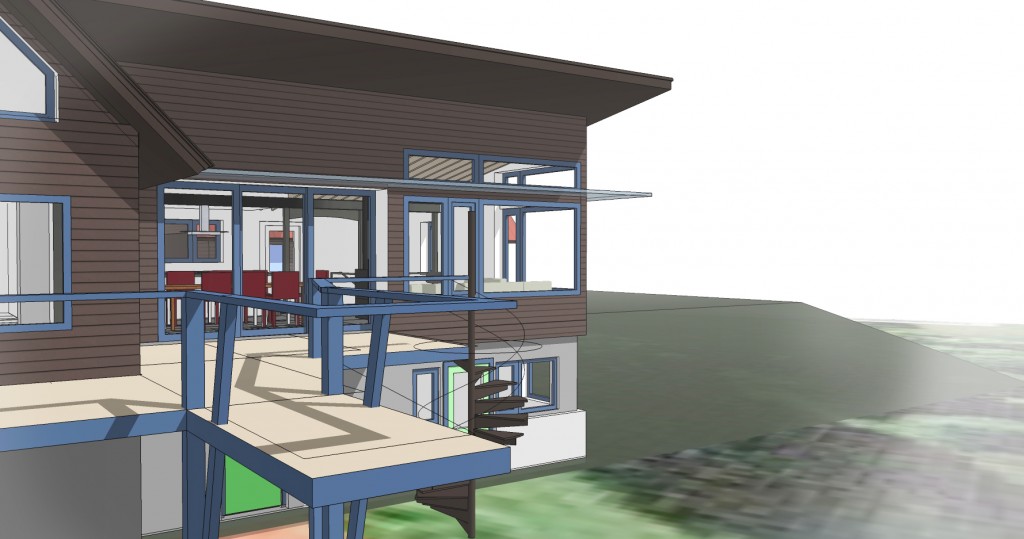
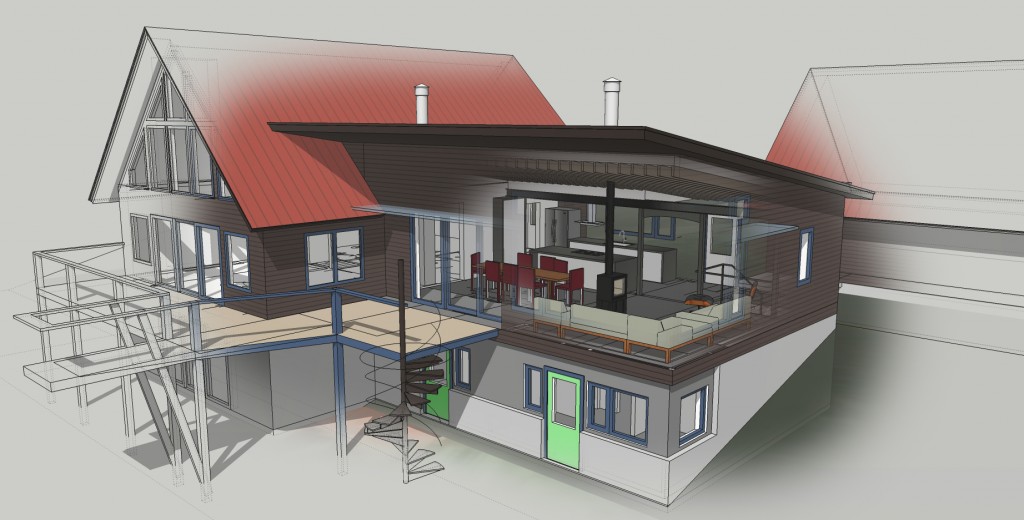 I am using big windows, wood, steel etc to create a warm, modern and relaxed space for lots of people to be in.
I am using big windows, wood, steel etc to create a warm, modern and relaxed space for lots of people to be in.
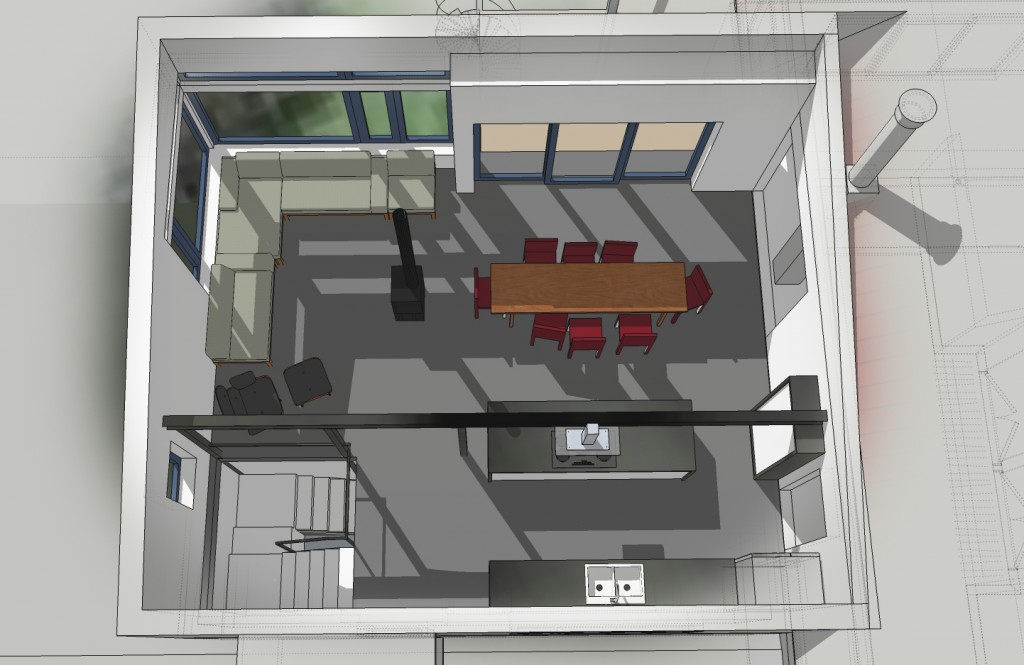
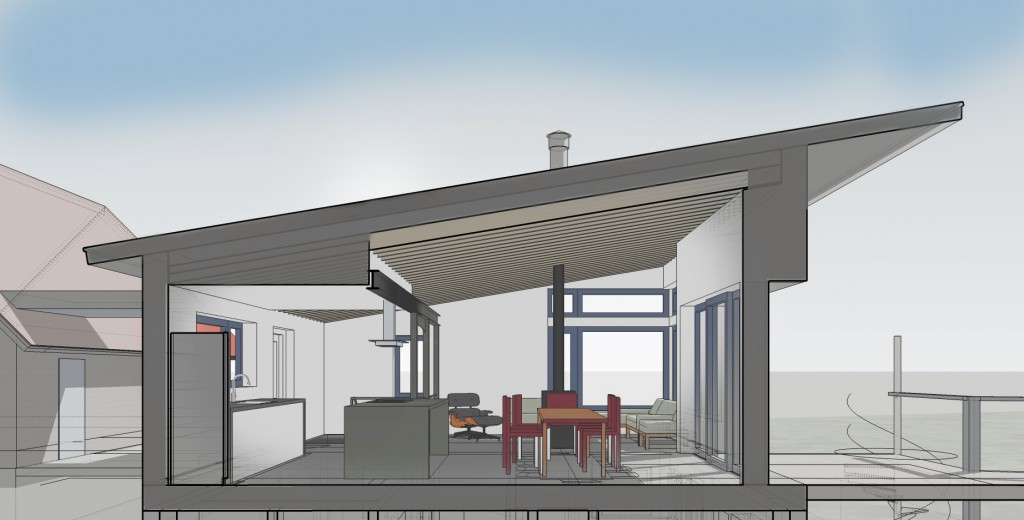 Here is the current plan:
Here is the current plan:
 and I put together a few videos of the sketchup model
and I put together a few videos of the sketchup model
Perry Road Realtor Listing
Tiny House Infographic from CustomMade
I was just emailed a link to this really excellent tiny house infographic and it seemed worth sharing. I would add to this the community building aspects of the tiny house movement.
Less Is More:The Tiny House Movement
Infographic by CustomMade
D2R2 2014
 I just registered for D2R2 - The Deerfield Dirt Road Randonnee Next Saturday. Will I see any of you there?
I just registered for D2R2 - The Deerfield Dirt Road Randonnee Next Saturday. Will I see any of you there?
Our vacation and train ride across the country - travel log
Every few years we we take a vacation! This time around it was to visit Seattle to say goodbye to my wife's family home which will be razed to make way for a bunch of poorly designed condos. The house is on a double wide lot in the Madison Valley neighborhood. The house itself is a nice little craftsman that would otherwise need a lot of work. The yard is full of plums, figs, apples, kiwi vines, blackberries and assorted other plants so the big sad thing for all of us is losing all that.
The neighborhood is being "gentrified" with new, maxed out square footage modern buildings with, for the most part, only a few token shrubberies.
The last straw causing my wife's folks to sell was when the neighbor's house came down and three new condo units went up, towering over their house. I toured the middle one at an open house and took pictures from the roof deck of the in-law's house. They developer built a retaining wall right up against the foundation of the in-law's house which was, apparently, illegal in this case but happens commonly because the hassle of litigation prevents most people from bothering and the fines for being found "at fault" are less than the profits from doing it in the first place. Apparently this was a utility easement not to be covered.
Seattle has most excellent playgrounds with much "vestibular stimulation" of which I availed myself on a few occasions, resulting in severe queasyness.
Vestibular play from Robert Swinburne on Vimeo.
The neighborhood had much interesting and new modern architecture to look at although Much of it involved gratuitous use of materials and forms (overdone) so I'm currently on modernist overload. Most of what I saw had little relationship to the site other than topography on sloped sites (long stairs outside of buildings) This is mostly because the new buildings were built for maximum square footage on a given lot. There was very little room for green space left over although there was much median strip gardening going on. There is still some pockets of eccentricity and a few green-space holdouts in the neighborhood but I fear that in 20 years, these too will disappear.
Seattle is nice and all. Charlotte poisoned pigeons in the Park (click link for original video of Poisoning Pigeons by Tom Lehrer)
But the funnest part of our trip for me was the Amtrak train ride out there. We Left Albany on an overnight Amtrak train to Chicago to visit Grampa Allen there. Our train was delayed for several hours near Gary Indiana and I shot this video with my I-phone:
IMG 1331 from Robert Swinburne on Vimeo.
I think these are mostly steel mills (?) There were miles and miles of colossal and fantastic architecture right along the train tracks. It was stunning.
There was a very cool thunderstorm in Chicago one night.
Chicago Derecho Storm Video and Time-lapse Highlights - June 30, 2014 from Craig Shimala on Vimeo.
In Chicago we went to the Museum of Science and Industry where Charlotte fell in love with model boats which fit in well with her long standing aspiration to become a pirate.
Here is a view of the back of the museum which is more interesting than the front - Other architects will know what I mean, we are always ducking around back of buildings for a look.
This area of Chicago fascinates me because of the 1893 Chicago World's fair with all the fascinating stories surrounding it (Read Devil in the white city) and all the amazing but temporary architecture.
We then continued on for two days to Chicago along Amtrak's northern route. This led through North Dakota and Montana before reaching Spokane and Western Washington. Our country is very flat in places.
I found it interesting nonetheless and was interested to see the "placemaking" efforts of small homes in the middle of nowhere. The usual tack was to plant trees and in some places you could see a grove of mature trees signifying that a house once stood in amongst them. Some folks planted in a regular and geometric fashion and others much more randomly but in many cases there was nothing at all save a few shells of abandoned buildings.
LOTS of room for wind and solar power.
http://vimeo.com/100851253
Things got hilly once we hit the Cascades.
We flew back to the East Coast at the end of our vacation but that was just a plain old boring plane ride. Although there was a full moon at sunset over Baltimore.
Now I'm back at work and the world didn't end without me.
Video Post
Lorem ipsum dolor sit amet, consectetur adipiscing elit. Morbi vitae dui et nunc ornare vulputate non fringilla massa. Praesent sit amet erat sapien, auctor consectetur ligula. Lorem ipsum dolor sit amet, consectetur adipiscing elit. Sed non ligula augue. Praesent imperdiet magna at risus lobortis ac accumsan lorem ornare. In aliquam, sapien ac vehicula vestibulum, arcu magna aliquet velit,
Marlboro, VT: High Performance House with Vapor-Open Walls and Roof
Kent and I have worked together a bunch in the past and we are working on a project currently. This is a lovely little project that illustrates how using a few very high performance products can allow us to reconsider how we use materials elsewhere, often going back to more traditional materials. Note: I had nothing to do with this one.I promise to get some more recent photos soon and there is a link below to the full article on foursevenfive.com


http://foursevenfive.com/marlboro-vt-high-performance-house-with-vapor-open-walls-and-roof/
A House for Slow Living
A House for Slow LivingThe original concept came to me in a dream (yes – I dream architecturally) I think the dream may have been generated by this image which has been on my bulletin board fora few years:
 The original sketch was called “a house for food”
The original sketch was called “a house for food”

The core concept was centered around the growing, preparation and consumption of food which lends itself to the idea of gatherings of family and friends and leads to the notion of how to live in a close relationship to the local environment. From my own experience I drew upon the old fashioned ideas of hunkering down by the fire on a cold winter evening, opening the house up to the sounds, smells and breezes of a summer day, “putting food by” and making routine preparations for winter in the Autumn, starting seedlings on a windowsill in the spring, caring for children or elders. Also, how can we appreciate the beauty of the winter landscape and light without feeling overcome by it. This is a common issue in the Northeast. Where do you sit to watch a thunderstorm rolling in or to watch the snow fall? Music! – not just acoustics but around here, everybody is also a musician. How does that fit into our daily lives? Much inspiration is to be found in images and stories depicting rural life from previous times in Europe and America. I am drawn to the imagery of hard working English country houses where the real life of the house centers between the kitchen and the door stoop leading directly to the working yard and gardens. Think: Peter Rabbit in Mr. McGregor’s Garden by Beatrix Potter with a potting shed, cold frames and lots of cabbages. I am fascinated by early New England farms and town dwellings and how lives were played out in them. Not the big events but the little, day to day, season to season routines. Light and fresh air are celebrated and sought after and even, perhaps, taken for granted in an age before television and telephones. Materials are worn but durable, practical and show their age and history and that is where their beauty lies.
The Building Science aspect of design and detailing that we are all so immersed in lately addresses the idea of being able to lock the door and walk away for a month in the winter and not worry about much of anything. The neighbor has the key and will water the plants. Building Science addresses being what we are calling “net zero” so you are not storing and burning fossil fuel on site and paying for it as well. Building Science addresses the notion of simplicity – who needs a heating system that could go on the fritz and bust your pipes and freeze all your house plants so when your neighbor comes over to water the house plants, he finds an awful mess and has to call you in some recently devastated country where you are doing relief work. Building Science allows you to return in March to a house filled with fresh air and no mildew. (building science can’t help with what you left in the fridge) Building Science can free you from many previously taken for granted maintenance issues and expenses such as painting and periodic repair, maintenance and replacement of the mechanical parts of the house because now you have fewer and simpler systems.
How then, to marry my heady and romantic thoughts with the physics of modern building science? How do I pack all of this sensuality and feeling into a house that celebrates the process of living this chosen life rather than reminding one of the potentially inherent drudgery? Since these ideas are very personal to me, it isn’t very difficult to make a series of design moves and decisions that bring me pretty close. I have been moving in this direction for much of my life. I am often “pretty close” but getting to that higher level is tricky and elusive. I’m not there yet with this design but it’s still early….
In this design, I'm trying to balance small and simple with a richness of space that goes far beyond light and shadow, a good floor plan and simplicity of form and add my own interpretation of what it can mean to live in Vermont and lead a life integrated with the climate and culture of the place. I'm drawing heavily on history and my own sense of aesthetics as well as all my cumulative observations and experience.
Dang! Maybe I should tear down my own house and build something like this!
For those interested in the Slow Living Movement, Brattleboro has a Slow Living Summit coming up in June associated with the Strolling of the Heiffers parade and festival.
Finding space without adding space
I did something for myself! Soon, we will be faced with fitting two kids in one small bedroom in our small house and I had some ideas spinning around in my head about how to make our limited space work much better. Size isn't everything - it's how you use it. These two images are packed with lots of little moves that add a ton of space especially storage and closet space. I put some Ikea bureaus in there from the Sketchup warehouse after removing the closets. Sometimes closets take up too much space for how much storage you gain from them and this is a perfect example. The kids each will get clearly defined space within one bedroom to minimize the inherent fratricide potential.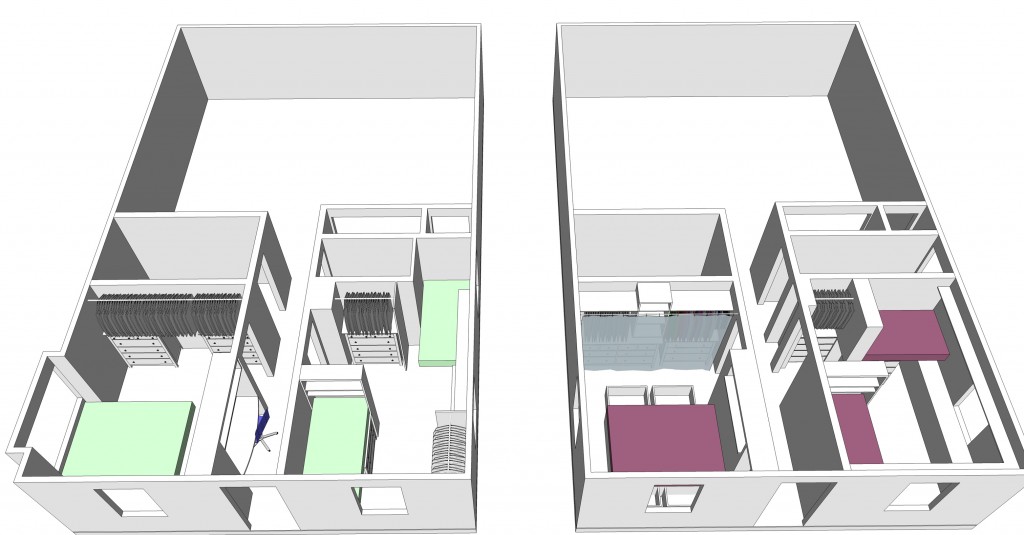
bob's bedrooms from robertswinburne on Sketchfab.
Passive House Training - One year later.
Note: this blog entry was published on Green Building Advisor on March 31, 2014 I have been asked about my Passive House consultant training by other architects enough times that I though I'd write up a quick synopsis, one year later.
For me, the Passive House training was very useful for several reasons, not the least of which was the networking aspect. It is a small community with some really great conversation happening and it is fun to be a part of that. There is a lot of controversy as well, especially on GreenBuildingAdvisor.com Such as where does the law of diminishing returns kick in when it comes to insulating and how to handle latent loads (excess moisture). Plus there's the whole U.S. vs the rest of the world thing which I won't go into as I find it rather annoying, or at least boring. Secondly, It represents state of the art science on how to build good buildings with an overriding emphasis on simplicity and quality. Passive House is really all about quality and even, as I'm finding out, represents a necessary re-thinking of how to get something built. A much more collaborative approach is necessary than often happens when building even high-end projects. The process gets much less linear. I also like the idea that the Passive House approach is a valid part of the conversation, not just achieving certification and getting the plaque to hang beside the front door. I see projects being showcased that utilized the approach in a value engineering manner to get the most bang for the buck that simply don't have the budget to go all the way and attain certification and I like the general consensus that that is okay. Much of my own work had been trending in the PH direction anyway so it was good to undergo the intensive training so that I could make decisions with much more confidence and authority that comes with PH credentials. As an architect who was never very (ahem) enthusiastic about the numbers and physics of things and more into the airy-fairy poetic nature and scholarly aspect of architecture it was also helpful in terms of training my weaknesses. I call myself a Passive House designer rather than a consultant in part because If I were to attempt a full-on certified Passive House, I would want to hire someone more experienced who does this on a daily basis to do the actual numbers part and look over their shoulder through the process - at least for the first few times. There is also the notion, similar to my approach to structural engineering where I try not to design anything too complicated to engineer myself - I prefer not to design anything that would require a complicated heating/ventilating system. It does get more complicated in renovation/addition work though for sure. My approach to structural engineering has always been very intuitive and very related to my own building experience and knowledge of materials, assemblies and connections My structural engineering professor once told me that the intuition part is vital and more than half the battle. First you intuit the solution then you apply numbers and formulas to check yourself. The Passive House training augmented my intuition and gave me more confidence to apply the numbers as well as a perspective on when, where and why.
Plus it was really good for marketing.
Houzz- Eric Reinholdt's ideabooks
I'm becoming a fan of Eric Reinholdt's Houzz ideabooks. His writing and editing is a cut above plus he has very similar tastes to my own so I look forward to each new ideabook. He also worked for one of my favorite firms in Maine - Elliot and Elliot Architecture.His Houzz page is HERE
And here area few of his ideabooks:
Recent Design Work

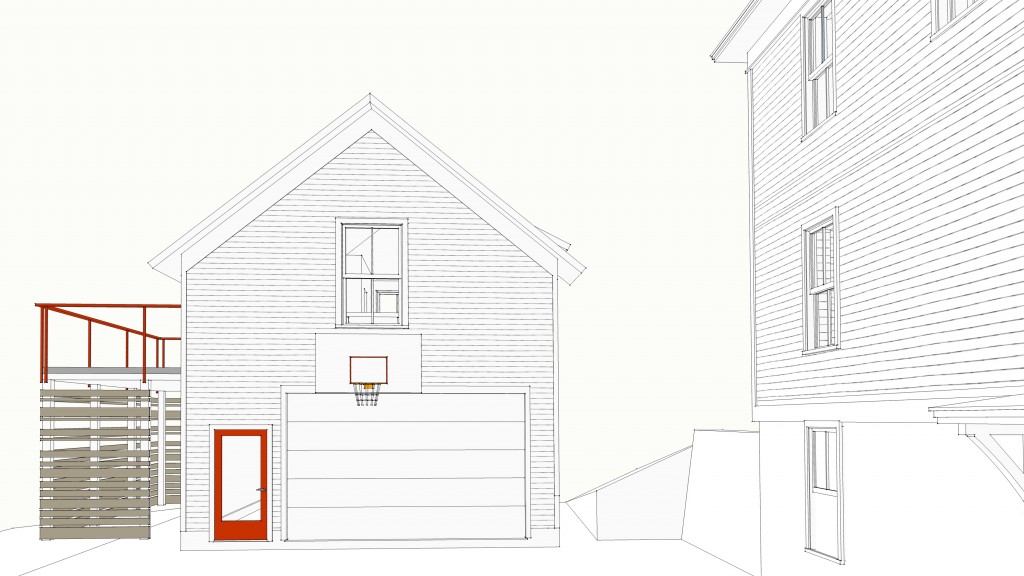
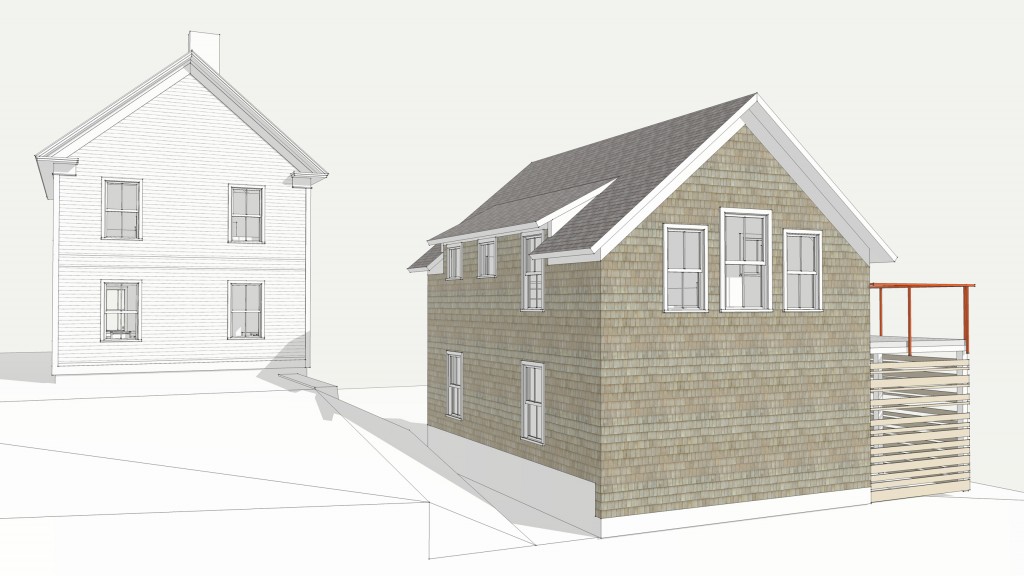
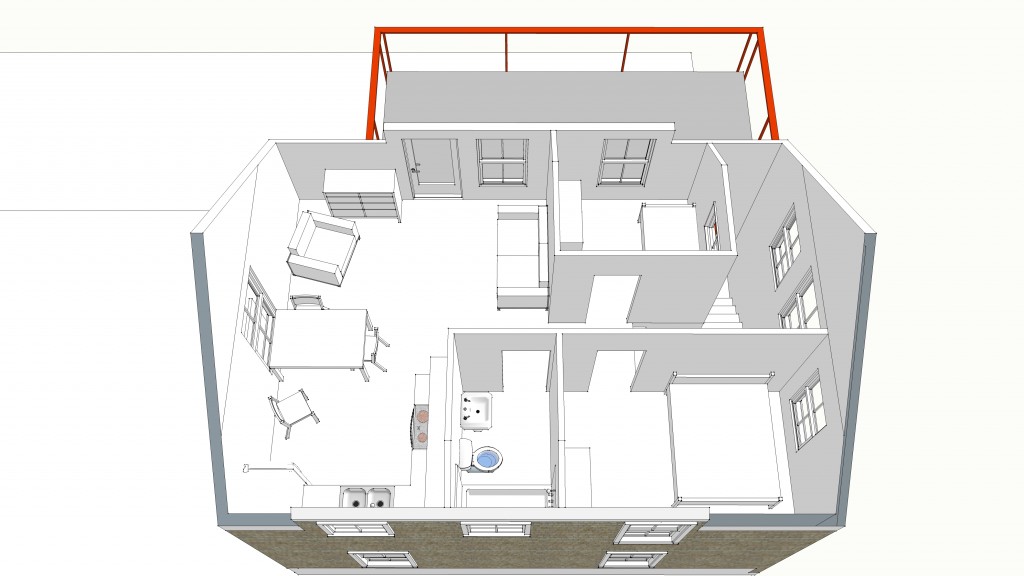
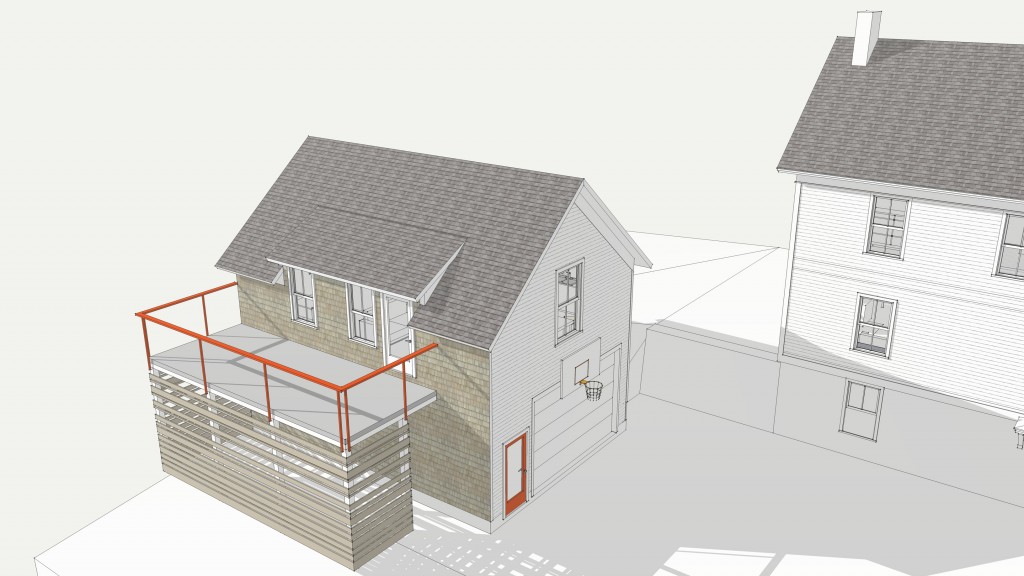 Then I looked at a larger barn with more "clipped" New England eaves. Need to work on the front windows. Traditional barns often utilized some asymmetry here but more modern barn builders seem to stick rigidly to symmetry. The side windows are not good however. -see last picture. Perhaps two large windows
Then I looked at a larger barn with more "clipped" New England eaves. Need to work on the front windows. Traditional barns often utilized some asymmetry here but more modern barn builders seem to stick rigidly to symmetry. The side windows are not good however. -see last picture. Perhaps two large windows
Photos! Stratton Modern is nearly complete
I visited a recent ski home project near Stratton mountain ski area to get some photos. The house is nearly complete. As usual there are things I would do differently next time and things that didn't quite follow the drawings but that's for me to know and no one else to notice. I really like the "presence" of this house. The coloring and materials are first rate. It is very "touchy feely" and very responsive to the changing light as the clouds raced across the sky. I can't wait to do the local, green hemlock over Solitex Mento again. and better. Click on the photos for big screen enjoyment.
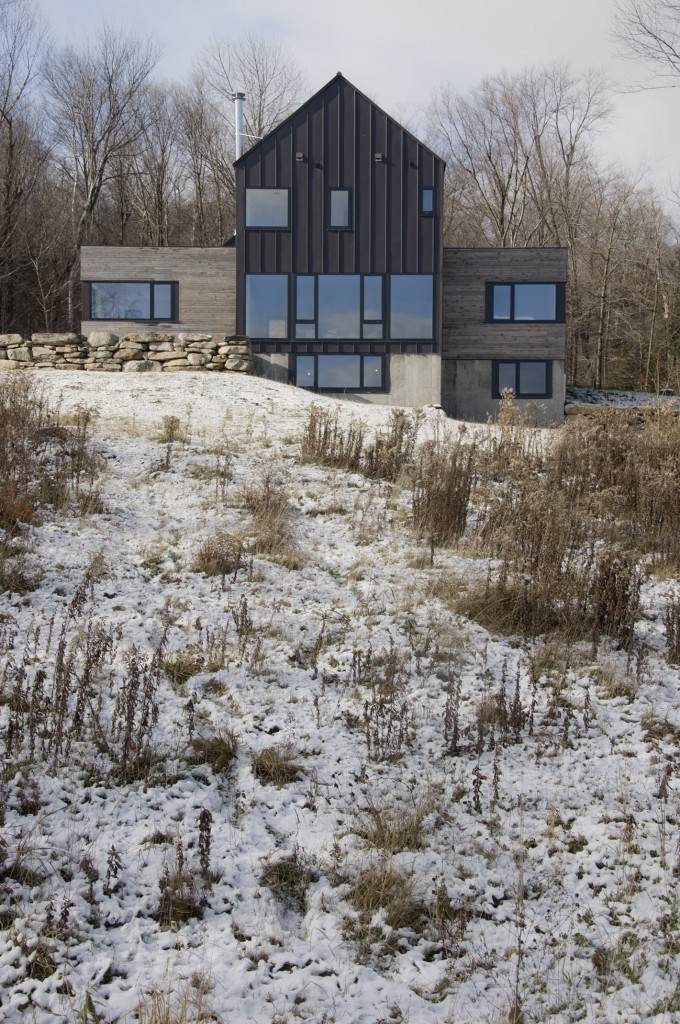
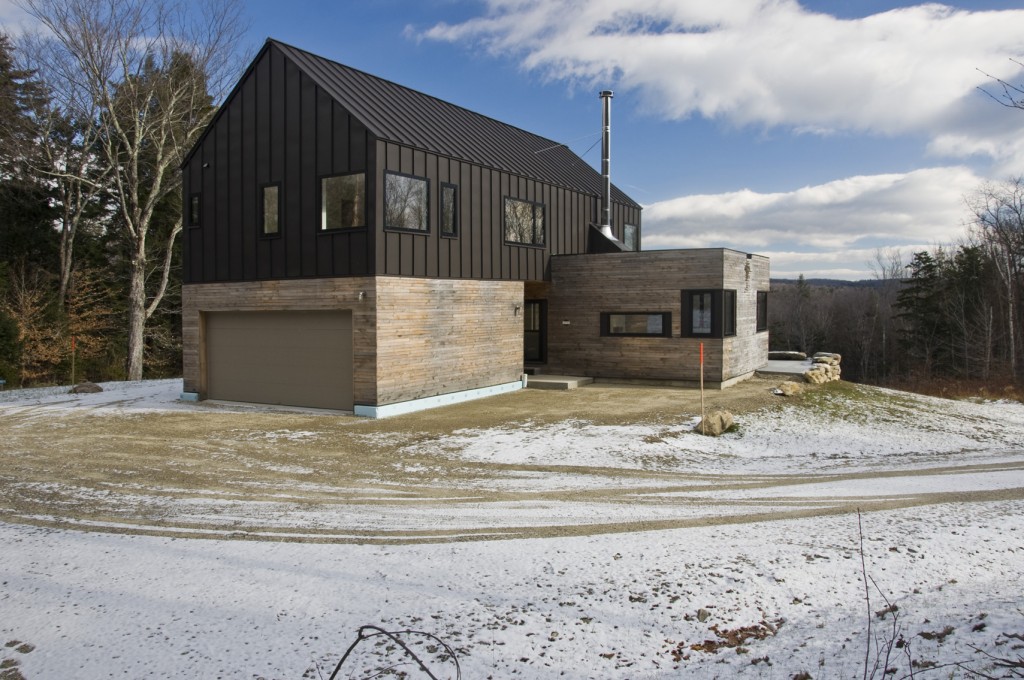
Mass MoCA in Adams Massachusetts
We visited the Massachusetts Museum of Modern Art - Mass MoCA in North Adams MA today to see Xu Bing's giant phoenix exhibit in the largest hall We come here several times a year and I usually walk around with my mouth wide open in amazement but this time I remembered to snap some photos. When I was in Architecture School, I would occasionally break into a gigantic old abandoned factory up the street from my apartment. At night, of course. It was relatively terrifying but also very peaceful. I remember lying on a parapet three stories up for half the night once just chilling out. The spaces, lit only by nearby streetlights, were beautiful. Mass MoCA is a large factory turned into a museum in such a way that much of that old factory architecture has not been lost or covered up or gentrified.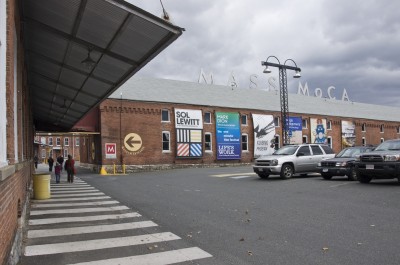
 Xu Bing: Phoenix
Xu Bing: Phoenix
 The kids were floored
The kids were floored
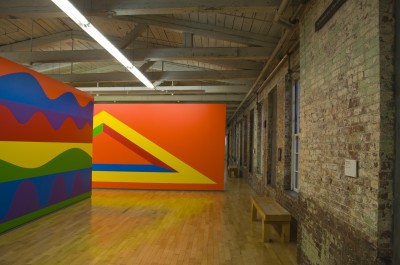 Sol Lewitt
Sol Lewitt
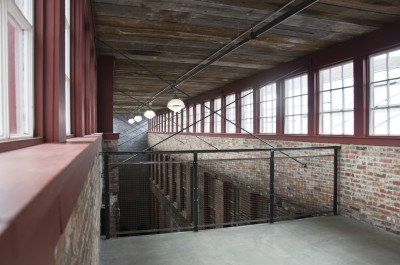 The celestory - a lovely space where there never seems to be anybody.
The celestory - a lovely space where there never seems to be anybody.
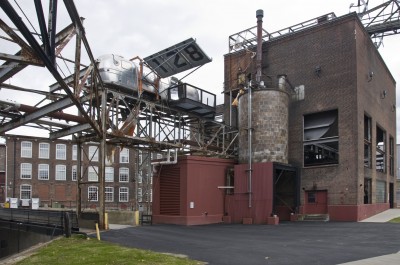 note the airstream - it's part of a Steam punk exhibit "Michael Oatman: all utopias fell" and you can climb up there and go in it
note the airstream - it's part of a Steam punk exhibit "Michael Oatman: all utopias fell" and you can climb up there and go in it
 They let you into the old boiler building - unsupervised - I could cut myself on rusty metal! It's actually an exhibit - "Stephen Vitiello: All Those Vanished Engines" complete with eerie sounds from hidden speakers that use some of the old empty rusting tanks as reverberation chambers.
They let you into the old boiler building - unsupervised - I could cut myself on rusty metal! It's actually an exhibit - "Stephen Vitiello: All Those Vanished Engines" complete with eerie sounds from hidden speakers that use some of the old empty rusting tanks as reverberation chambers.
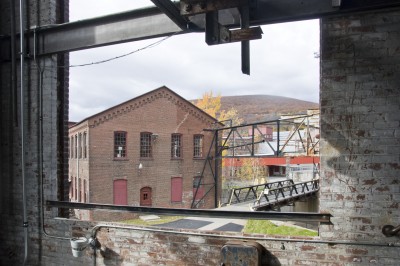
 Excellent detailing with raw steel - one of my favorite materials
Excellent detailing with raw steel - one of my favorite materials
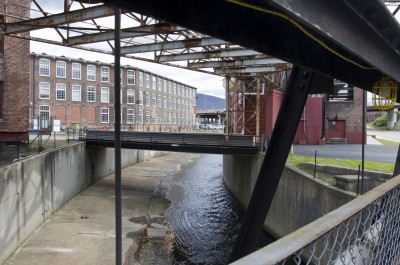 A river runs through it.
A river runs through it.
 The old building is not at all lost or buried as so often happens.
The old building is not at all lost or buried as so often happens.
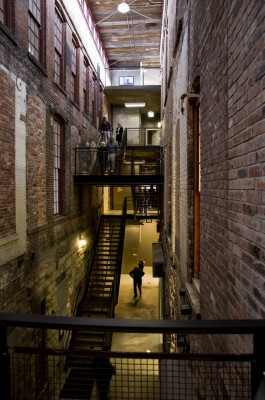 One of my favorite spaces at Mass MoCA is this tall narrow in-between space.
One of my favorite spaces at Mass MoCA is this tall narrow in-between space.
And the cafeteria actually has really good food and not too expensive - a toasted bagel was less than 1$
Well worth a day to visit. Also, drive (or ride your bike) to the top of Mt. Greylock nearby and check out the Clark which has some amazing art as well as a Tadeo Ando building.
